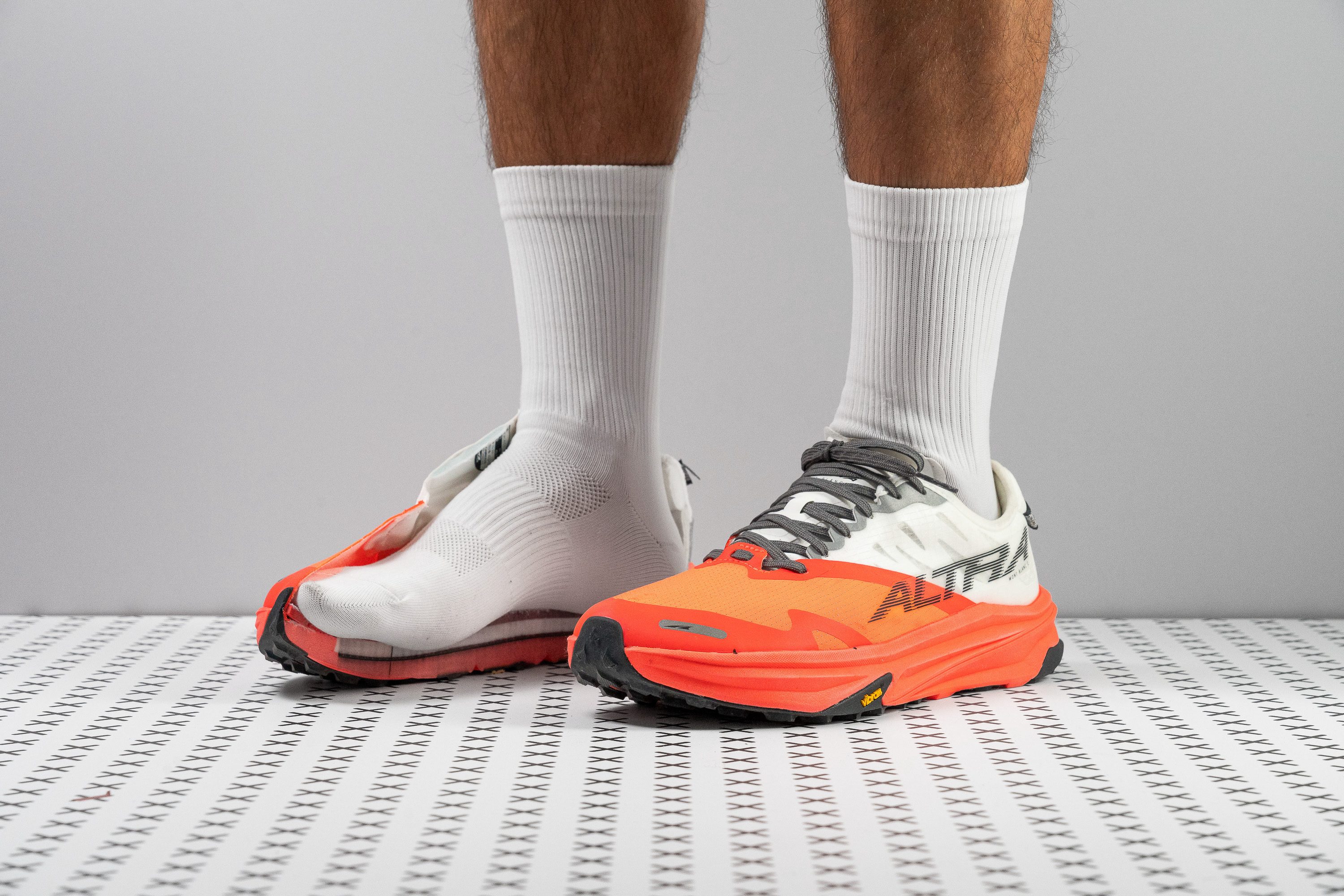Our verdict
- Top pick in best Altra trail running shoes
Pros
- True Altra DNA!
- Responsive and fast
- Superior Vibram Megagrip outsole
- Excellent durability
- Remarkably lightweight
- Authentic zero-drop experience
- Rounded, anatomic toe cap
- Adaptable across various paces
Cons
- Limited energy return
- Priced high
Audience verdict
- Top 29% in Altra running shoes
Comparison
The most similar running shoes compared
+ + Add a shoe | |||||
|---|---|---|---|---|---|
| Audience score | 86 Good! | 80 Good! | 82 Good! | 78 Decent! | |
| Price | $260 | $155 | $175 | $130 | |
| Trail terrain | Moderate | LightModerate | LightModerate | LightModerate | |
| Shock absorption | - | Moderate | Moderate | - | |
| Energy return | - | Low | Moderate | - | |
| Arch support | Neutral | Neutral | Neutral | Neutral | |
| Weight lab Weight brand | 8.9 oz / 251g 9.3 oz / 264g | 9.5 oz / 269g 9.8 oz / 277g | 12.6 oz / 357g 12.5 oz / 354g | 9.6 oz / 272g 9.1 oz / 258g | |
| Drop lab Drop brand | 0.3 mm 0.0 mm | -0.1 mm 0.0 mm | 0.7 mm 0.0 mm | 0.1 mm 0.0 mm | |
| Strike pattern | Mid/forefoot | Mid/forefoot | Mid/forefoot | Mid/forefoot | |
| Size | True to size | Half size small | Half size small | Slightly small | |
| Midsole softness | Soft | Balanced | Balanced | Balanced | |
| Difference in midsole softness in cold | Normal | Small | Normal | Normal | |
| Plate | Carbon plate | ✗ | ✗ | ✗ | |
| Toebox durability | Decent | Good | Very good | Very bad | |
| Heel padding durability | Bad | Decent | Good | Decent | |
| Outsole durability | Good | Good | Good | Good | |
| Breathability | Moderate | Moderate | Breathable | Breathable | |
| Width / fit | Medium | Wide | Medium | Medium | |
| Toebox width | Wide | Wide | Wide | Wide | |
| Stiffness | Stiff | Stiff | Stiff | Stiff | |
| Torsional rigidity | Flexible | Stiff | Stiff | Moderate | |
| Heel counter stiffness | Flexible | Moderate | Moderate | Flexible | |
| Lug depth | 3.5 mm | 3.0 mm | 3.5 mm | 3.3 mm | |
| Heel stack lab Heel stack brand | 27.2 mm 29.0 mm | 28.6 mm 29.0 mm | 32.2 mm 35.0 mm | 22.1 mm 20.5 mm | |
| Forefoot lab Forefoot brand | 26.9 mm 29.0 mm | 28.7 mm 29.0 mm | 31.5 mm 35.0 mm | 22.0 mm 20.5 mm | |
| Widths available | Normal | Normal | Normal | Normal | |
| For heavy runners | ✗ | ✗ | ✓ | ✗ | |
| Season | All seasons | All seasons | SummerAll seasons | SummerAll seasons | |
| Removable insole | ✓ | ✓ | ✓ | ✓ | |
| Orthotic friendly | ✓ | ✓ | ✓ | ✓ | |
| Ranking | #180 Top 48% | #310 Bottom 17% | #275 Bottom 26% | #332 Bottom 11% | |
| Popularity | #282 Bottom 24% | #141 Top 38% | #112 Top 30% | #278 Bottom 25% |
Who should buy
After pushing the Mont Blanc Carbon to its limits, we highly recommend it for:
- Zero drop enthusiasts seeking a carbon-plated trail shoe for either short bursts or ultra races.
- Forefoot or midfoot strikers who appreciate a Vibram outsole and a roomy upper in a performance-oriented shoe.
- Anyone looking for a carbon-plated trail shoe that still offers flexibility and comfort, rather than stiffness—truly a gem in today's market.
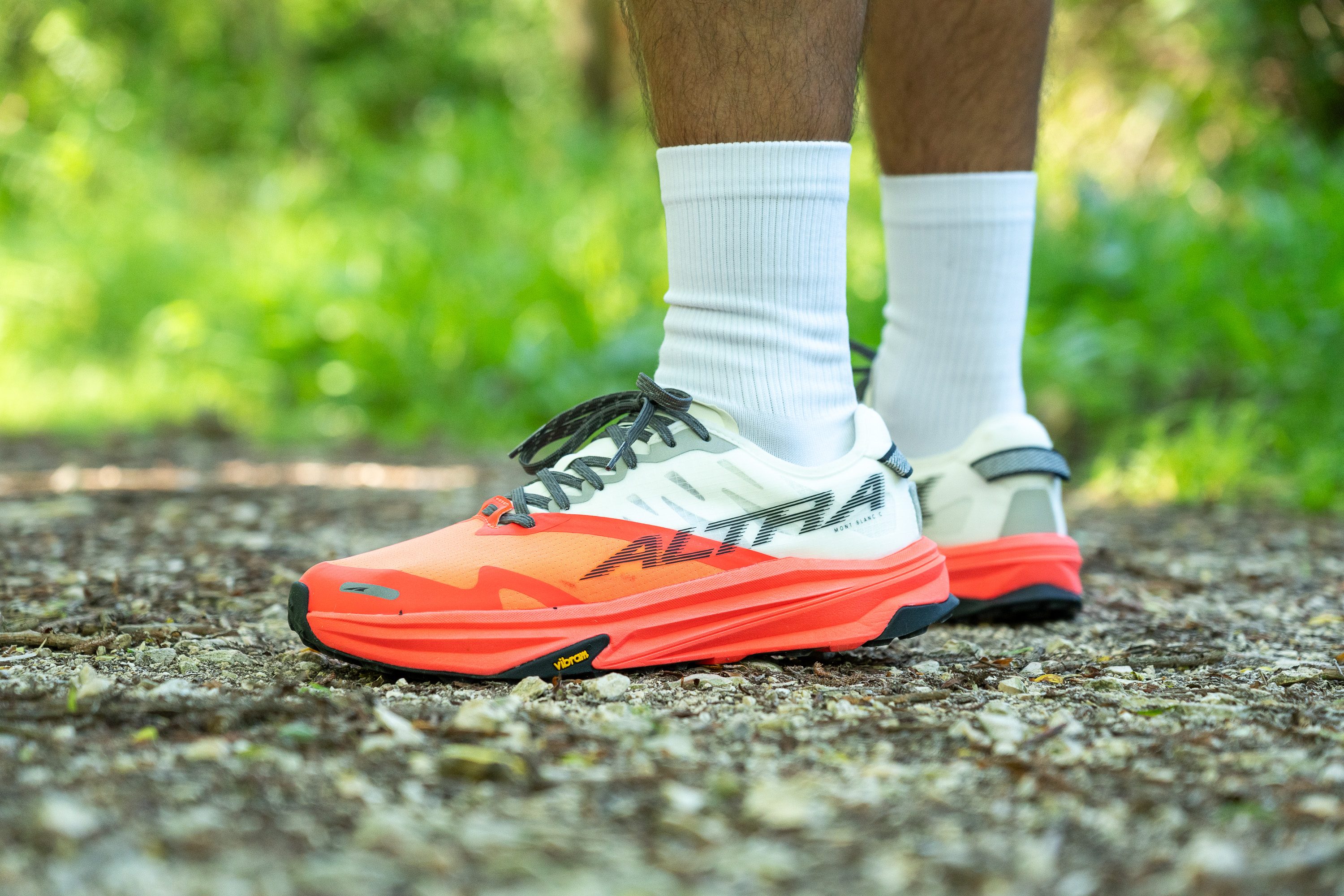
Who should NOT buy
We do not recommend the Mont Blanc Carbon for those seeking peak performance on trails—it falls short due to its mid-tier foam, which lacks optimal energy return, and its flat carbon plate that doesn't aggressively enhance propulsion. Instead, we suggest checking out the Nike Ultrafly, which boasts a full-length ZoomX midsole for superior performance.
Additionally, we believe the Mont Blanc Carbon is not the best choice for heel strikers—the 0-mm heel-to-toe drop and non-rockered geometry may slow you down and cause discomfort in your calves or Achilles. For heel strikers, we recommend the Hoka Tecton X 2, which offers similar features with a low drop configuration but is much better suited for those who strike with their heel first.
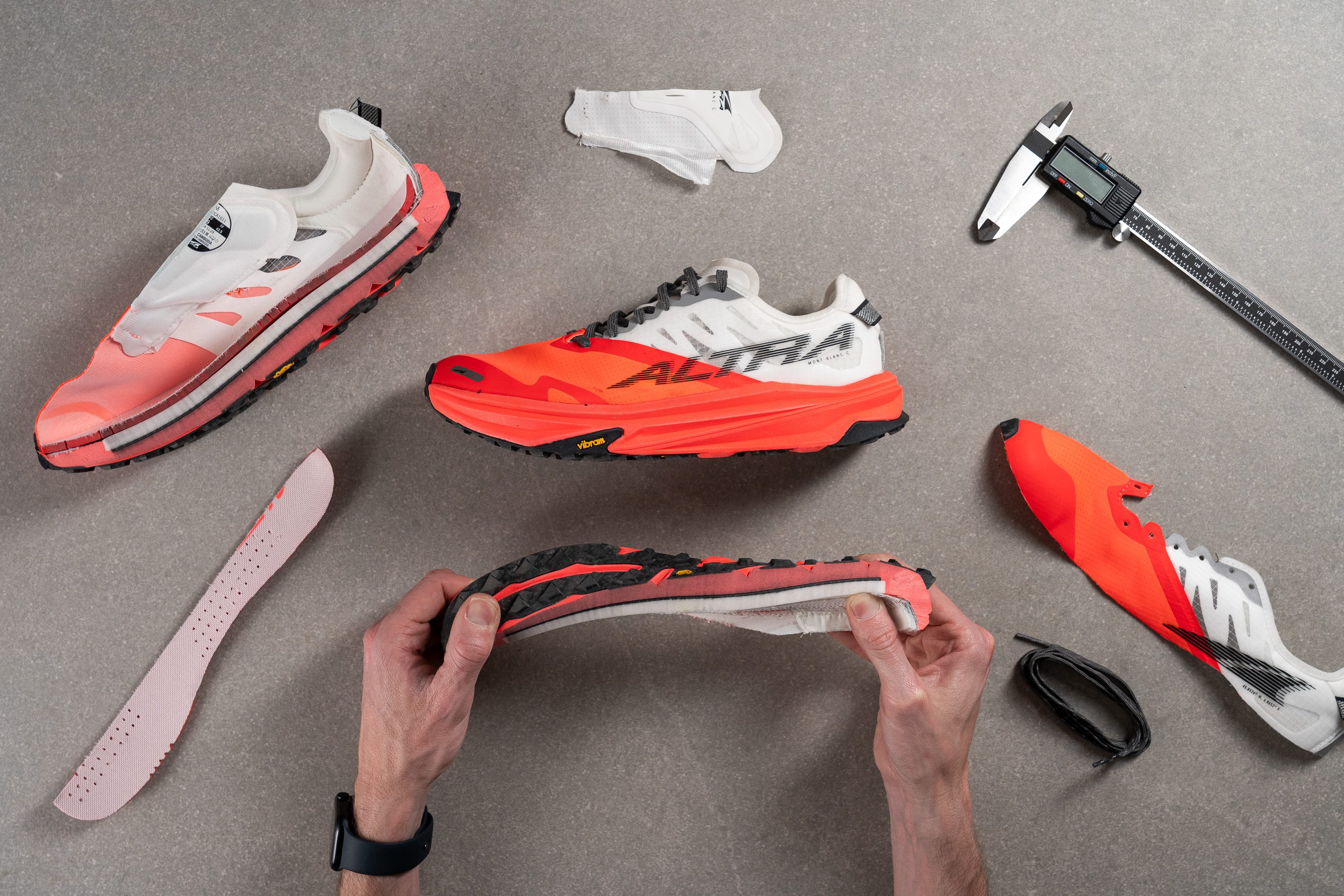
Cushioning
Heel stack
Altra advertises the heel stack at 29 mm, yet our precise measurements showed it to be slightly less at 27.2 mm. This minor discrepancy is virtually undetectable during a run.
While less than 30 mm might seem modest for a racing shoe, it's important to remember that Altras are designed for midfoot and forefoot strikers. Therefore, avoiding maximalist cushioning in the heel is a good idea, as it prevents unnecessary weight, enhancing the shoe's overall performance.

| Mont Blanc Carbon | 27.2 mm |
| Average | 32.6 mm |
Forefoot stack
The forefoot boasts a 26.9 mm stack, aligning it with competitors in the carbon-plated category, such as the Saucony Endorphin Edge.
While some individuals tackling pancake-flat ultras might prefer a bit more stack, most trail races cover a diverse range of terrains. This design choice is prudent, allowing runners to conserve his legs while maintaining good stability and agility.
In trail running, compromises are unavoidable...
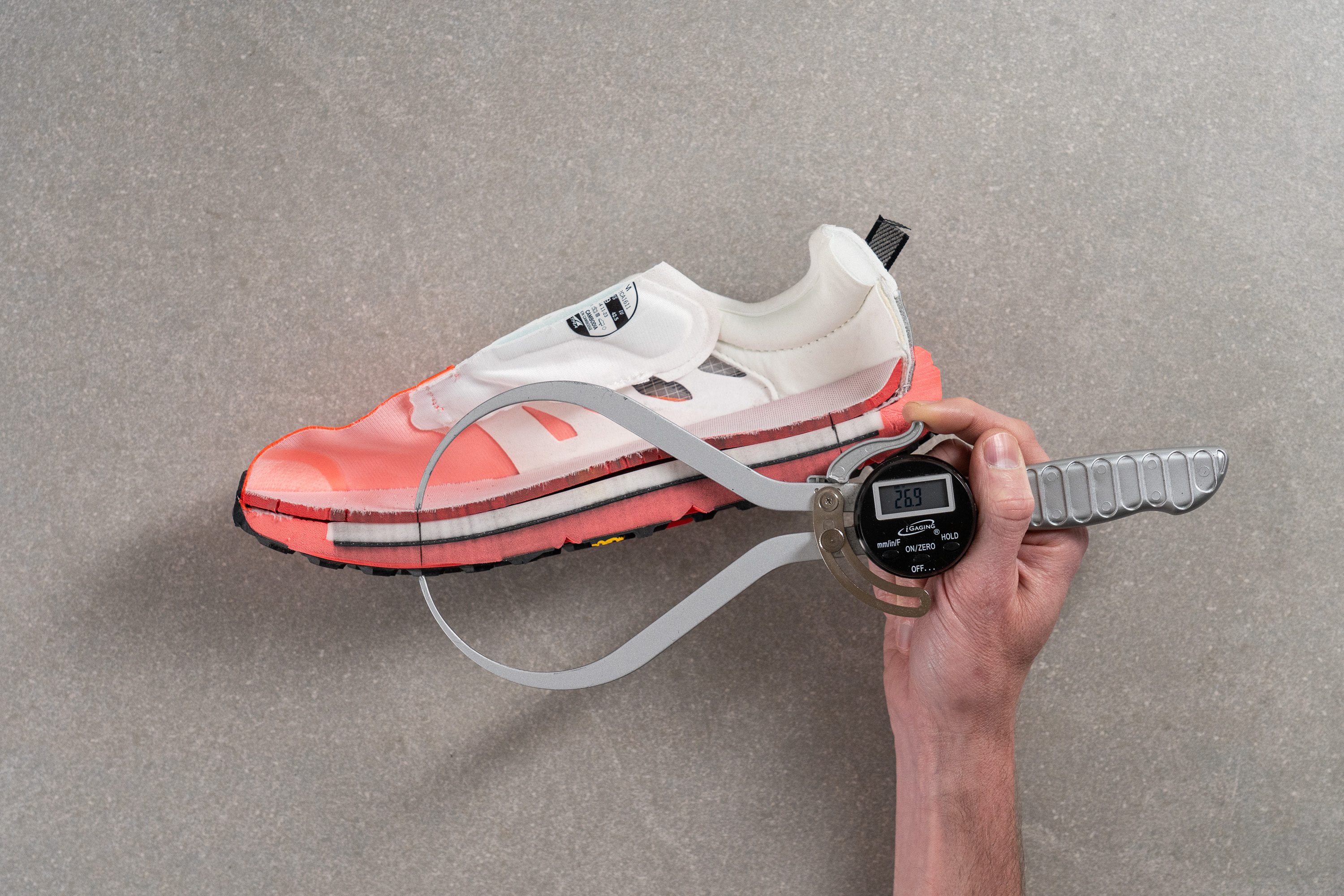
| Mont Blanc Carbon | 26.9 mm |
| Average | 25.1 mm |
Drop
The difference between our previous two measurements results in a 0.3-mm heel-to-toe drop, remarkably close to the official 0.0 mm that Altra claims for the Mont Blanc Carbon.
This slight variation is not a concern for us. Moreover, it's well within typical manufacturing tolerances, or even the slight shifts that can occur simply from using the shoe for a few runs. In fact, it's quite common for us to encounter differences of 3 or 4 mm in our measurements!
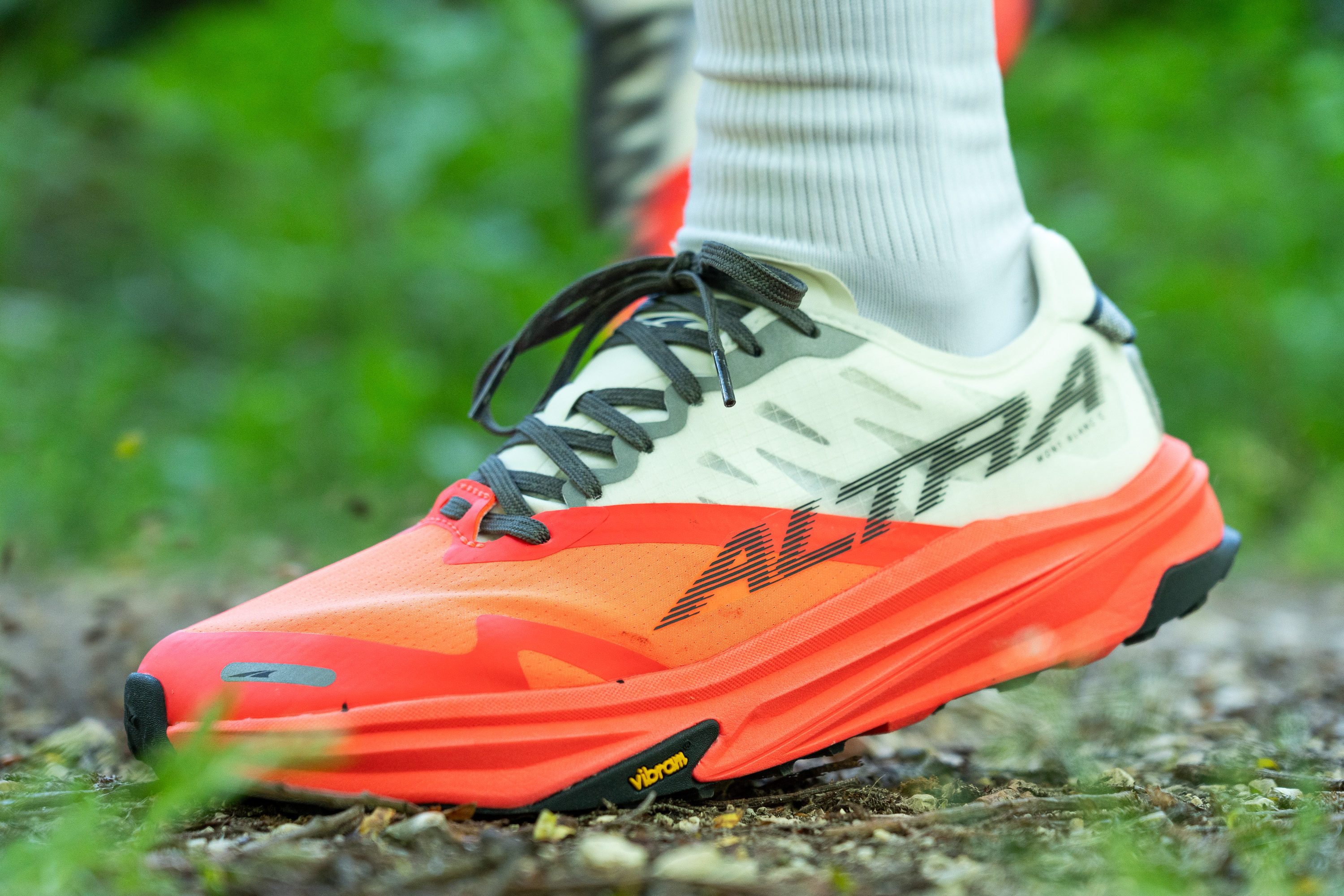
| Mont Blanc Carbon | 0.3 mm |
| Average | 7.5 mm |
Midsole softness
The midsole of the Mont Blanc Carbon is interesting, featuring not just one, but two distinct types of foam. The primary foam is EGO MAX (19.6 HA), a blend of EVA and TPU, which serves as the base for the EGO PRO layer that we'll discuss shortly.
From our perspective, the EGO MAX foam represents one of the weaker aspects of the shoe, preventing us from classifying it as a true supershoe. Additionally, considering the $260 price tag, we feel that a midsole composed entirely of PEBA would be more fitting, though it seems we may have to wait until v2 for such an upgrade.
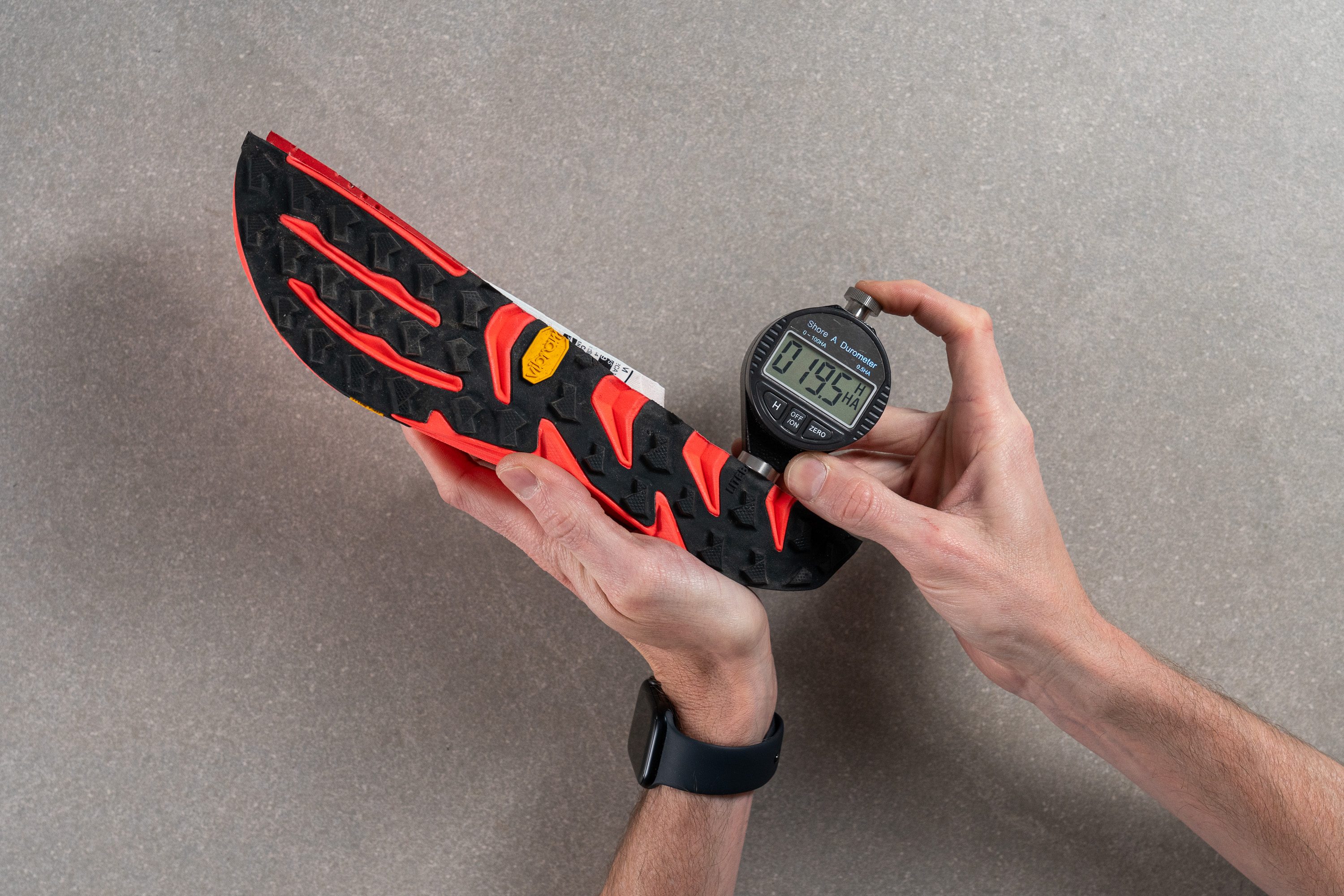
| Mont Blanc Carbon | 19.6 HA |
| Average | 21.9 HA |
Secondary foam softness
The secondary foam, which is white, sits above the plate and is only visible once the shoe is cut in half. So, it's no surprise if this is the first time you're hearing about it in a review of the Mont Blanc Carbon.
Although it has the same balanced softness at 19.6 HA, this foam is distinctly different—bouncier than EGO MAX and made from TPE, not the EVA and TPU blend. In our view, a full-length EGO PRO layer would have been a better choice for this shoe while Altra develops a PEBA foam.
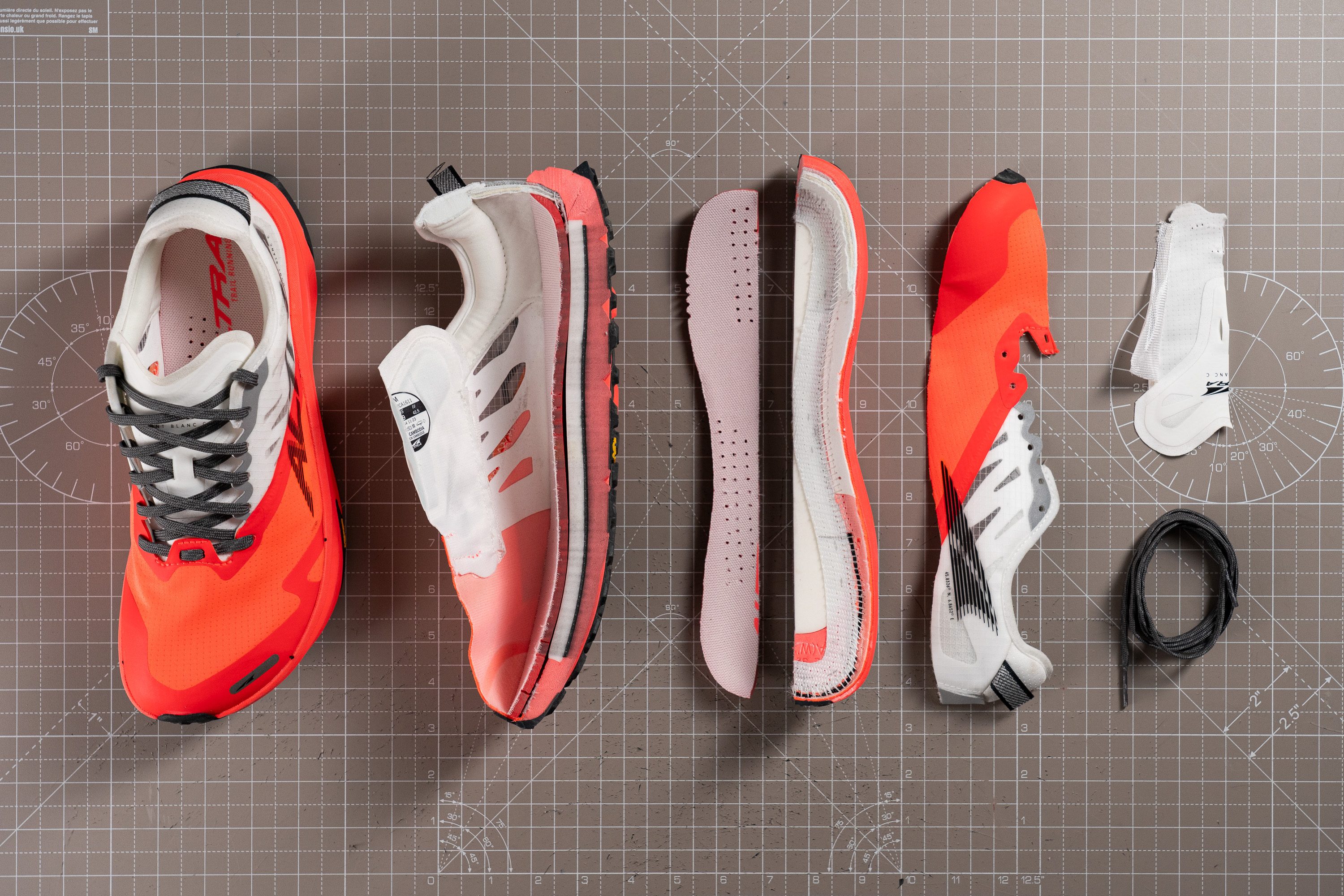
| Mont Blanc Carbon | 19.6 HA |
| Average | 25.3 HA |
Plate
The name "Carbon" in Mont Blanc Carbon stems from the inclusion of a carbon-fiber plate, a highly anticipated feature by Altra fans. And it’s here, though it's not your average plate.
Upon cutting the shoe in half, we discovered that the plate’s geometry is very flat, instead of being curved at the forefoot. This design choice prioritizes stability over other speed, which is not a bad thing at all, especially for trail running. But dont expect the quick turnover featured by a spoon-shaped plate like the one in a Nike Vaporfly 3.
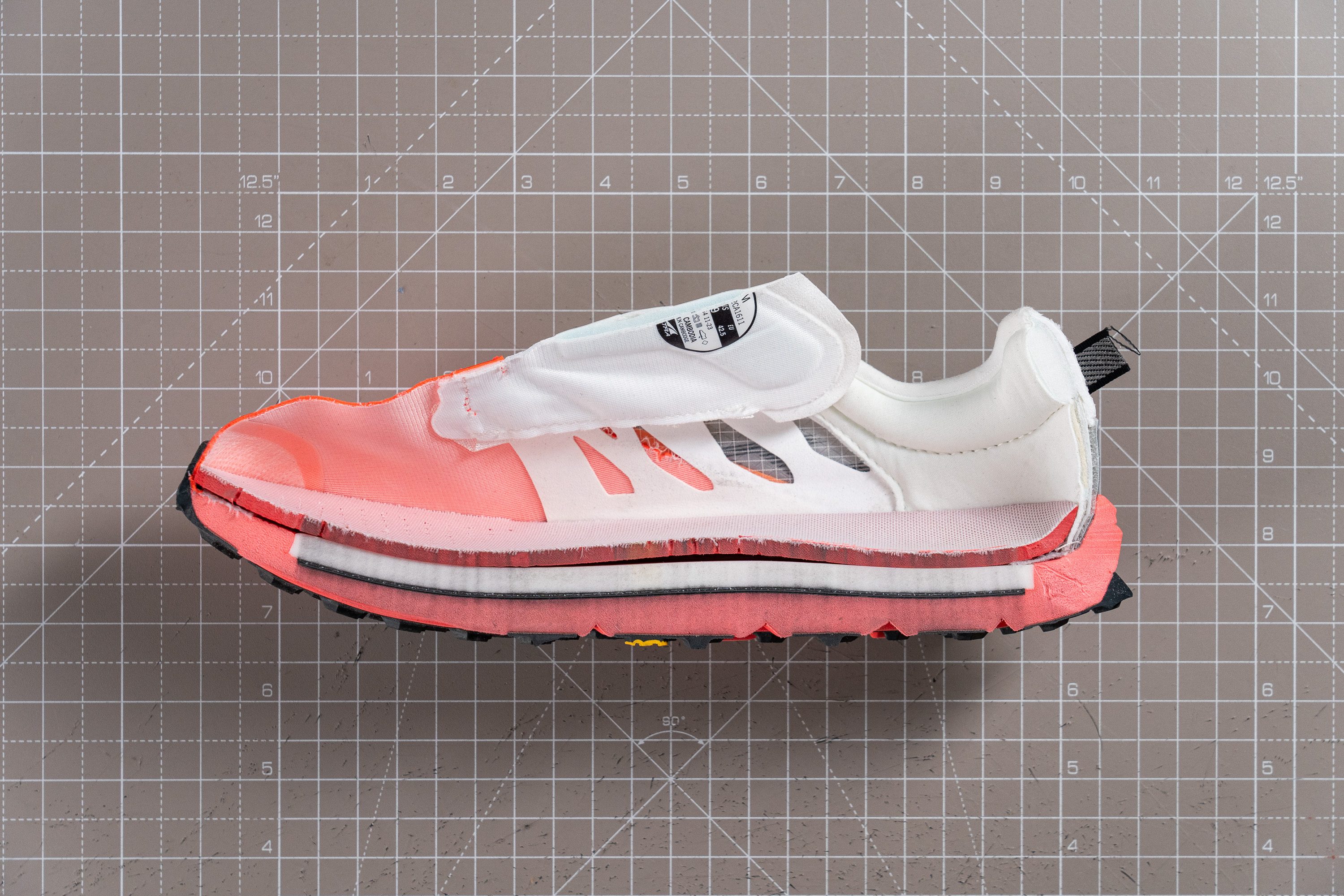
Size and fit
Size
Altra Mont Blanc Carbon fits true to size (13 votes).
Width / Fit
If you were hoping for a super-wide fit, the Mont Blanc Carbon might not meet your expectations.
At 96.6 mm, this shoe offers a width that is fairly typical, similar to most shoes on the market indeed. However, as with every Altra shoe, there's a catch...

| Mont Blanc Carbon | 96.6 mm |
| Average | 95.6 mm |
Toebox width
Despite featuring Altra's Slim FootShape design—the narrowest of their three options—it still offers an anatomically respectful toebox that honors the natural shape of the foot.
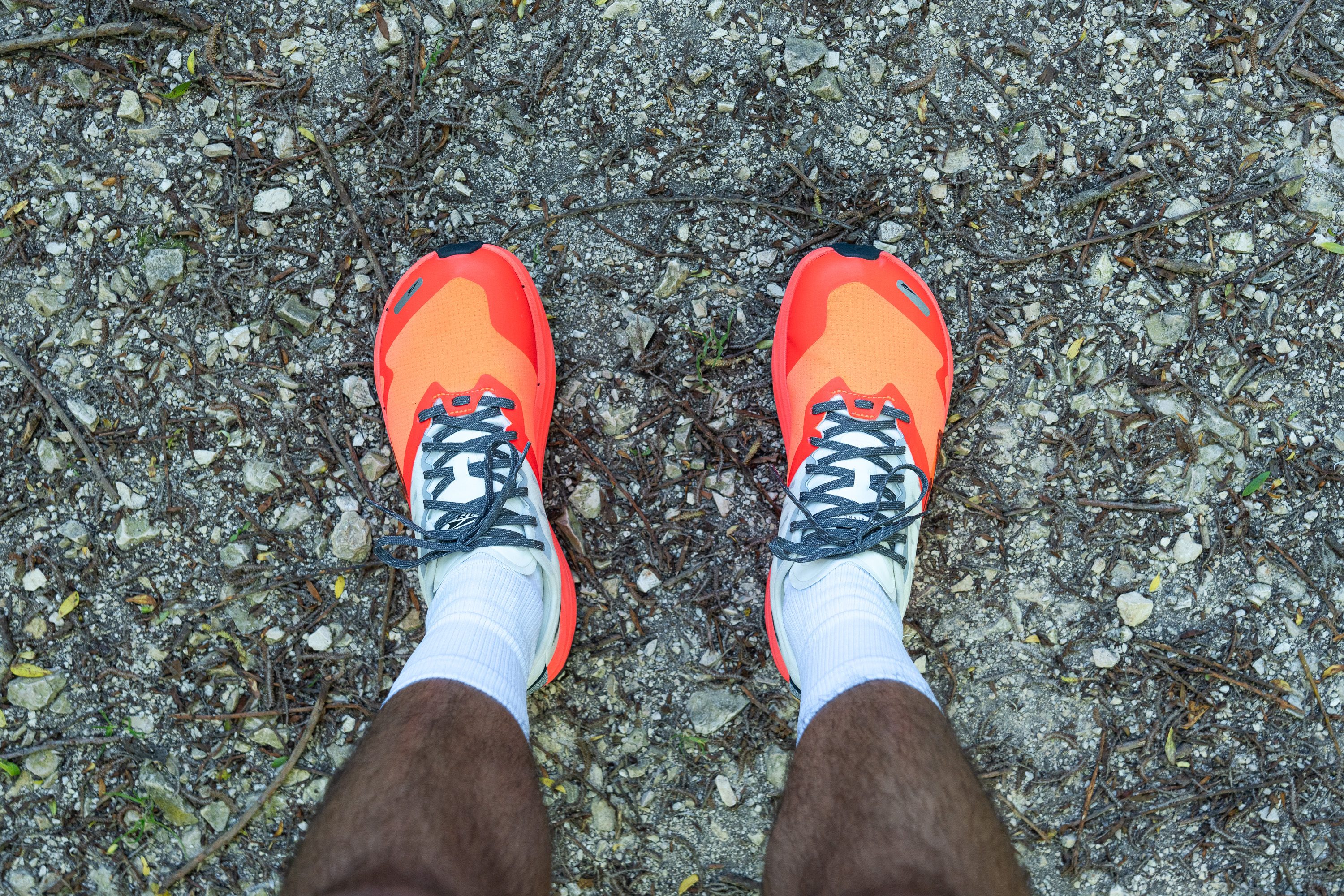
Measuring 79.9 mm in the big toe area, it easily surpasses the average trail shoe, making the Mont Blanc Carbon a superb choice for runners with wide feet.
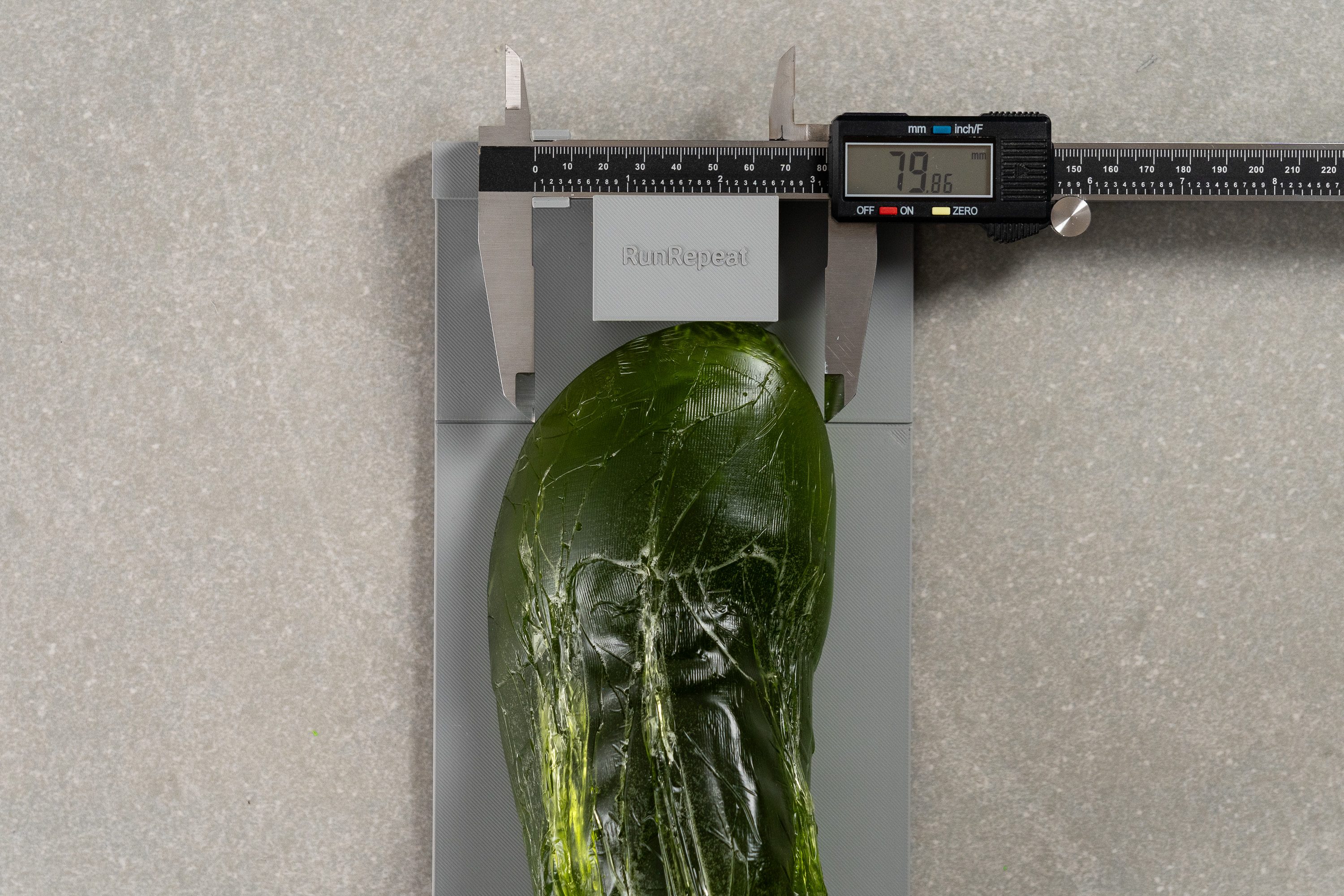
| Mont Blanc Carbon | 79.9 mm |
| Average | 74.6 mm |
Toebox height
The third measurement brought exciting news for enthusiasts of high-volume and roomy uppers. We found 29.9 mm of height, providing excellent vertical space for toe movement.
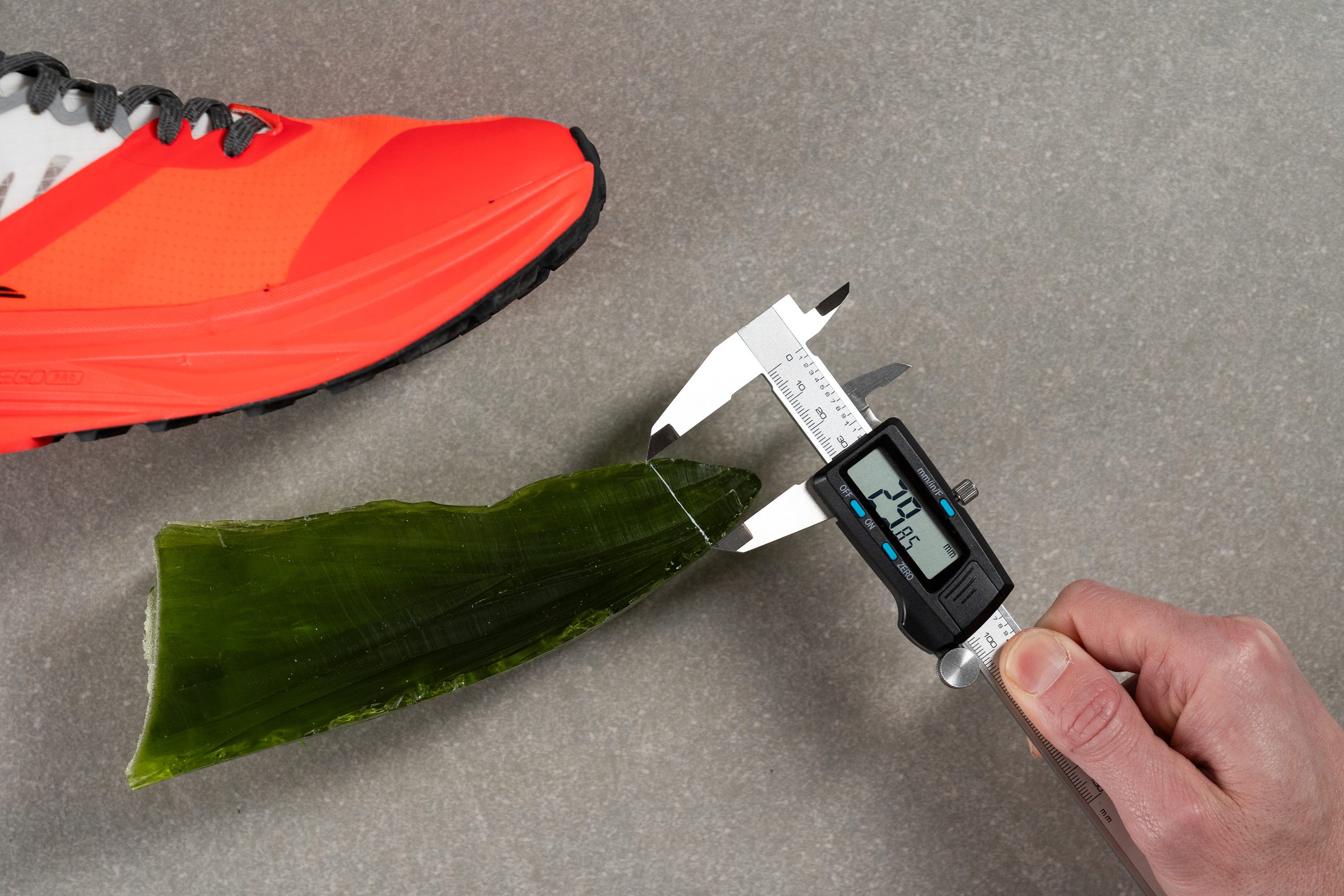
| Mont Blanc Carbon | 29.9 mm |
| Average | 27.1 mm |
Traction / Grip
Lug depth
Returning to the outsole, we once again used our vernier calipers to measure the lugs, which measured 3.5 mm.
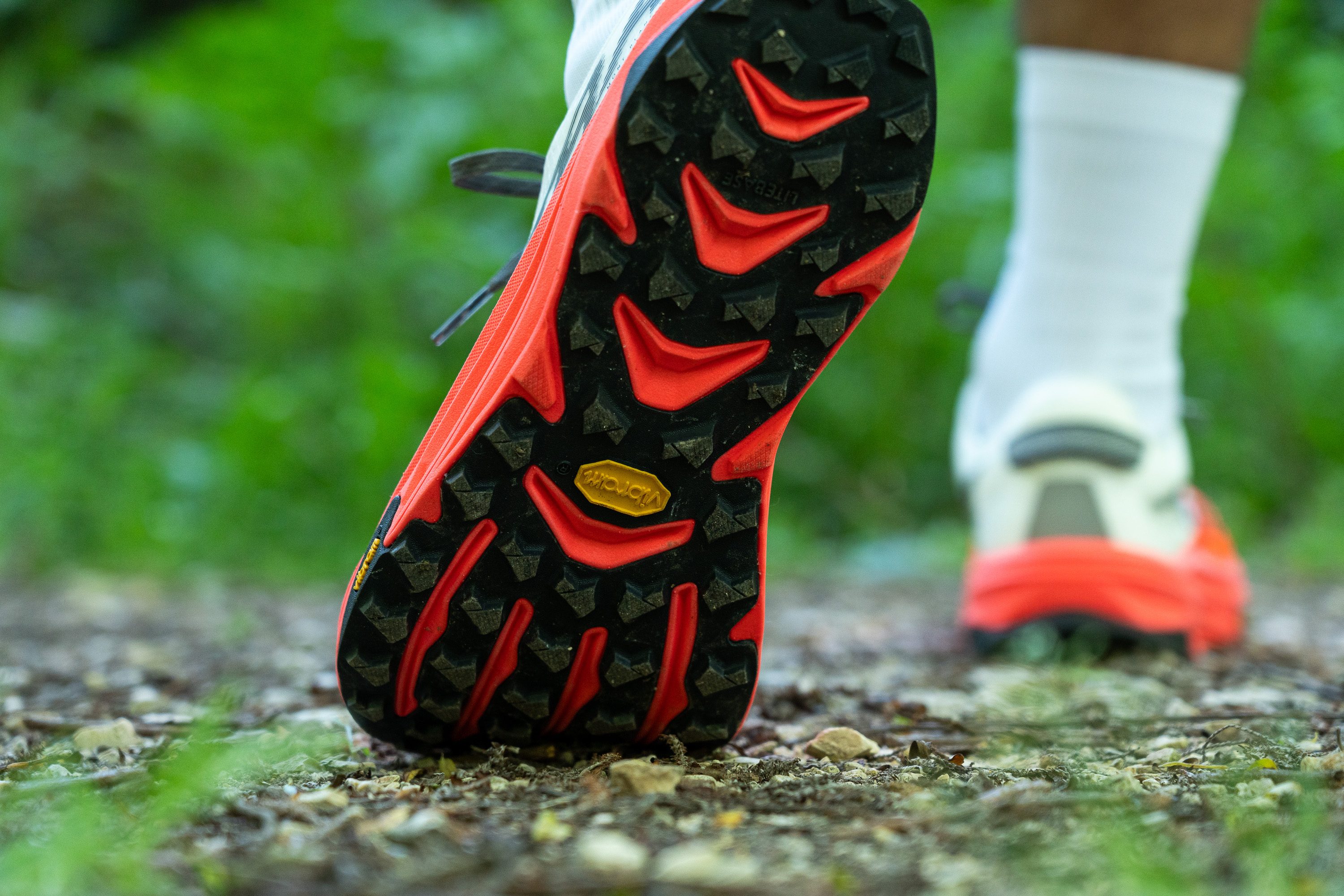
This is a standard design that provides solid performance across most terrains, though it doesn't specialize in any particular type. From our lab analysis and test runs, the MBC seems best suited for non-technical terrain and appears specifically designed for American ultras.
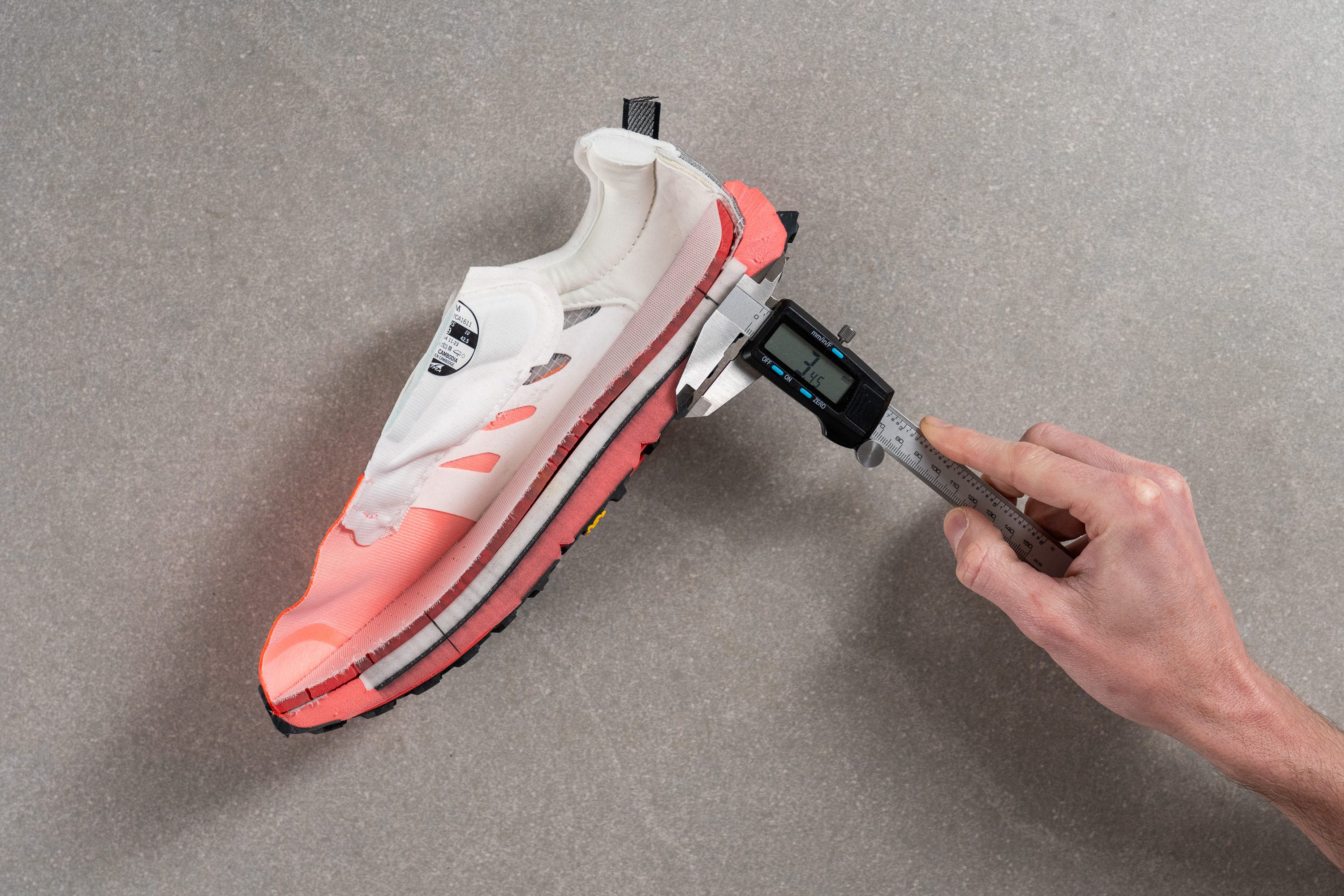
| Mont Blanc Carbon | 3.5 mm |
| Average | 3.5 mm |
Flexibility / Stiffness
As we demonstrated in our previous torsional rigidity tests, the Carbitex Monoflex plate in the MBC offers remarkable flexibility. This was further confirmed in our 90-degree bend test, where our force gauge recorded only 22.9N—lower than many plateless shoes!
This means that, despite being equipped with a carbon plate, the shoe feels exceptionally comfortable underfoot. It performs well at slower paces and is equally comfortable for walking.
This test follows an older methodology, which is why you don't see recently tested shoes in the chart. Results from different methodologies can not be compared.
| Mont Blanc Carbon | 22.9N |
| Average | 27.1N |
Stiffness in cold (%)
We repeated the test after placing the shoe in the freezer for 20 minutes to see if the stiffness changed under cold temperatures.
After re-measuring with the force gauge, the result showed only a 26% increase in stiffness, which is a positive outcome in our view, likely due to the presence of the carbon plate.
| Mont Blanc Carbon | 26% |
| Average | 32% |
Weight
Speaking of weight, we discovered that the Mont Blanc Carbon is exceptionally lightweight, tipping the scales at just 8.9 oz or 251g.
This is a good weight for being a trail shoe, considering the lugs, and protective features can add up to 2 ounces.
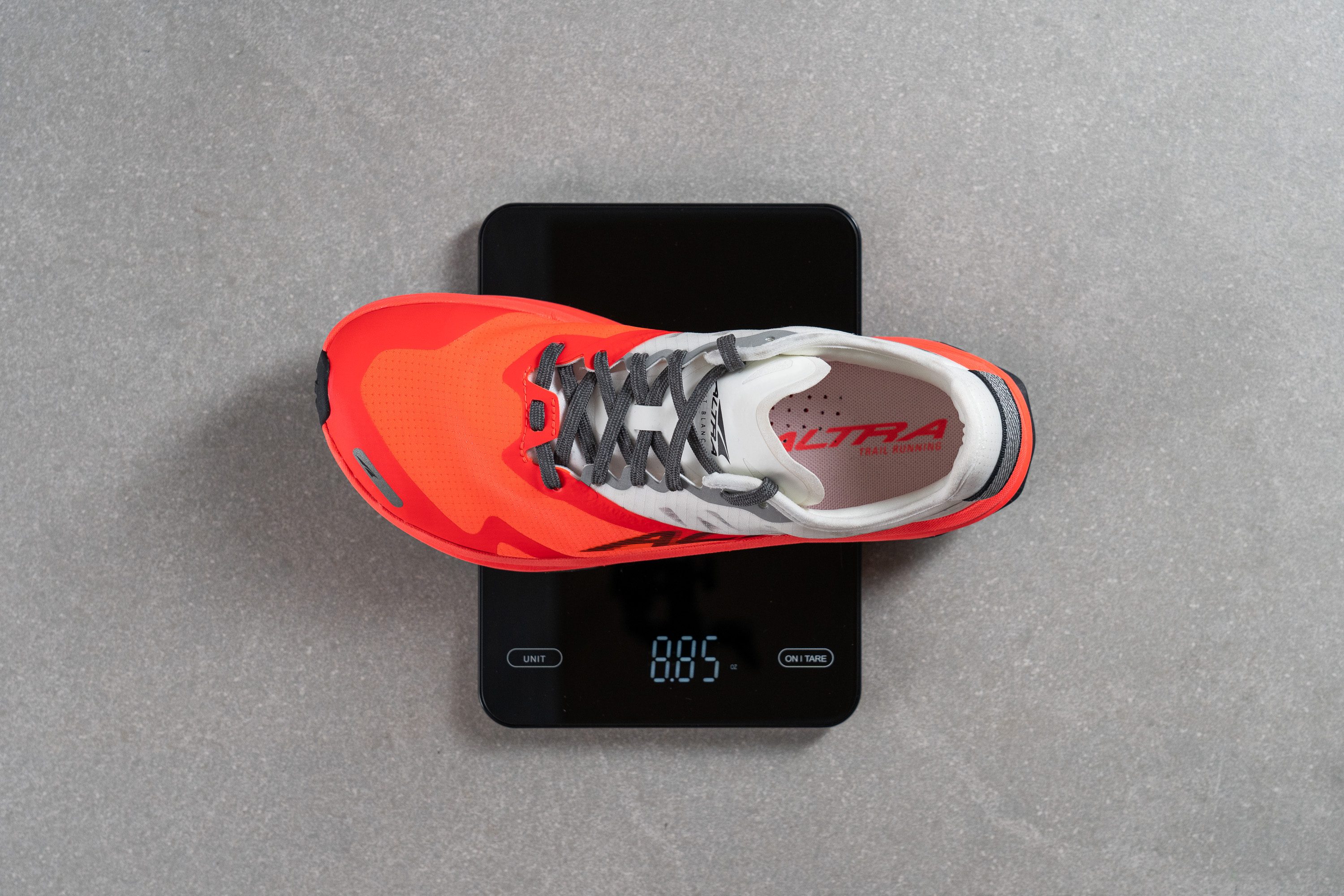
| Mont Blanc Carbon | 8.9 oz (251g) |
| Average | 10.2 oz (289g) |
Breathability
The Mont Blanc Carbon features an ultra-thin, monomesh upper, which ensures that, despite lacking large ventilation holes, it still offers decent breathability.
In our tests using a smoke-pumping machine, we observed that the toebox can expel a small amount of heat and humidity, while the bulk escapes through the tongue—sufficient for us to rate this shoe a solid 3 out of 5. This score reflects a good design for a trail kick.
With the aid of a light, we pinpointed the surprising thinness of the upper and the substantial structural reinforcements included to enhance stability.
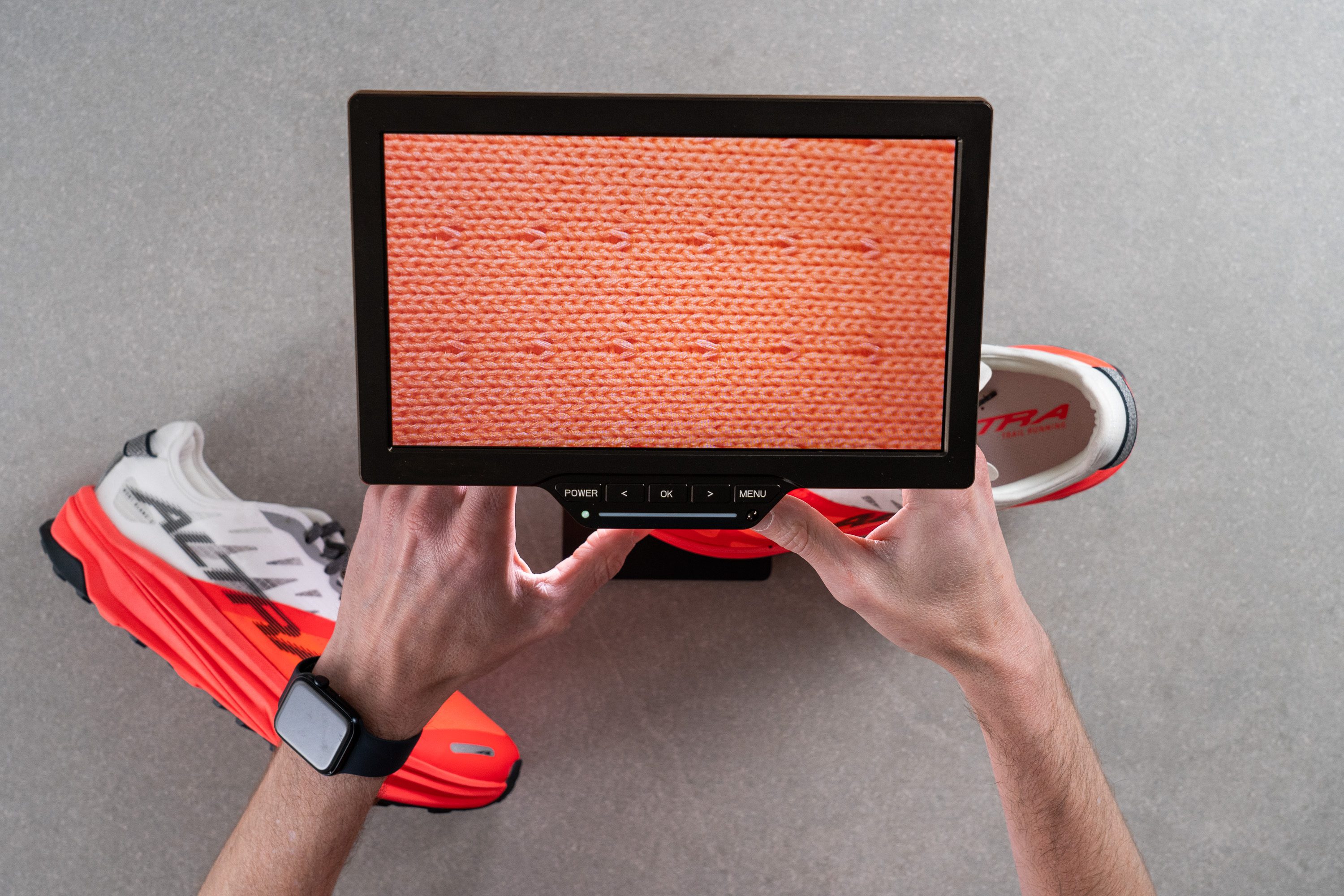
Next, we examined the engineered mesh under a microscope to get a closer look.
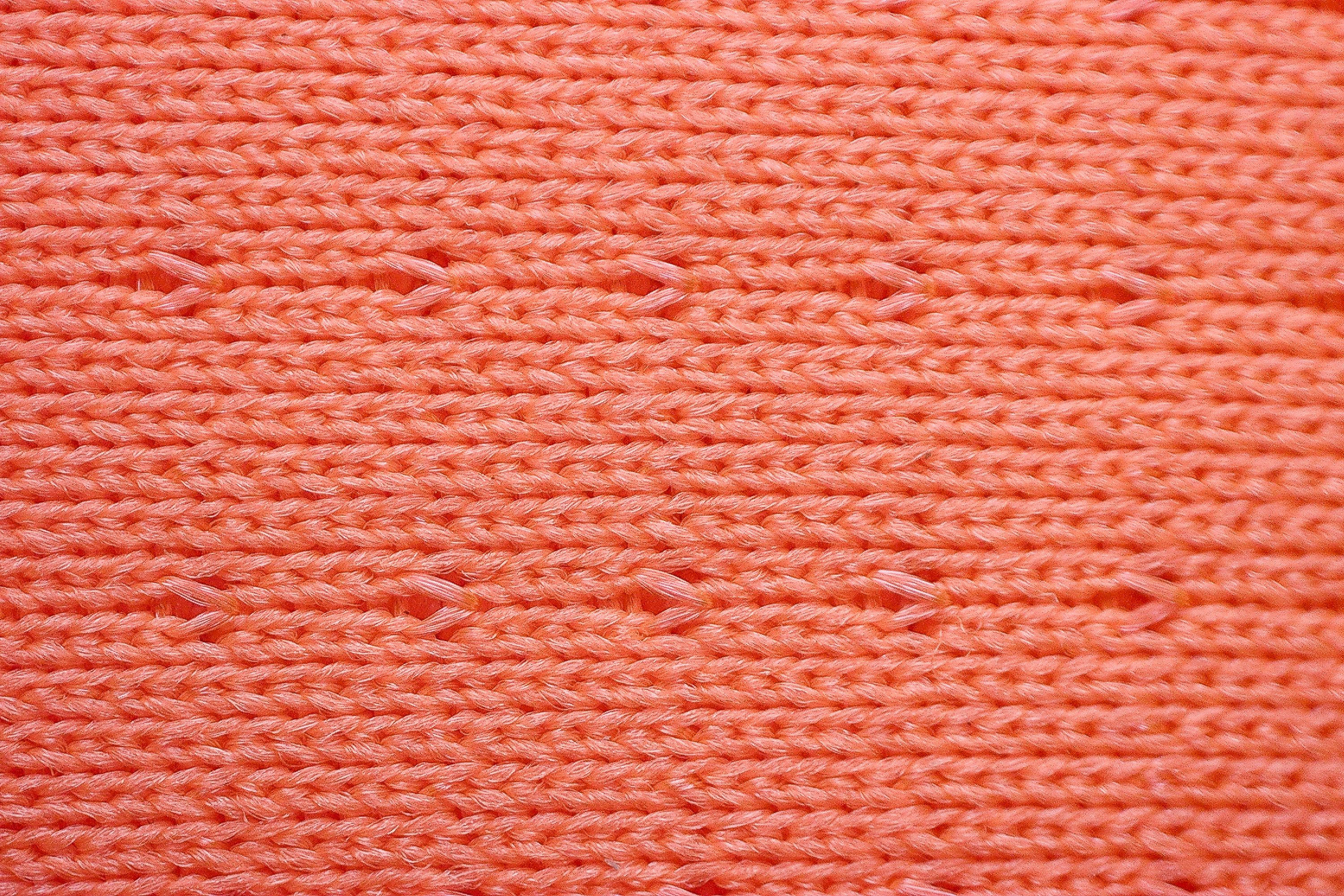
What we love most about using the microscope is how differently the upper appears. We were able to identify the tiny ventilation holes spaced a few millimeters apart.
Finally, we inspected the sliced upper. For a race shoe, we believe that it's adequately padded and that the build quality is comparable to other Altra shoes.
| Mont Blanc Carbon | 3 |
| Average | 3.2 |
Stability
Lateral stability test
The MBC may not be the most stable trail shoe on the market, but it performs good enough for us, especially considering its narrower build.
It was during our test runs that we realized the importance of the flat plate—it plays a crucial role in providing additional support for this shoe.
Torsional rigidity
One of the remarkable features of this running shoe is its incredible flexibility, despite incorporating a carbon plate. You might be puzzled—how is this possible? How did it score a 2/5 on our torsional rigidity test when other carbon-plated shoes typically score 4/5 or 5/5 and feel rigid like steel?
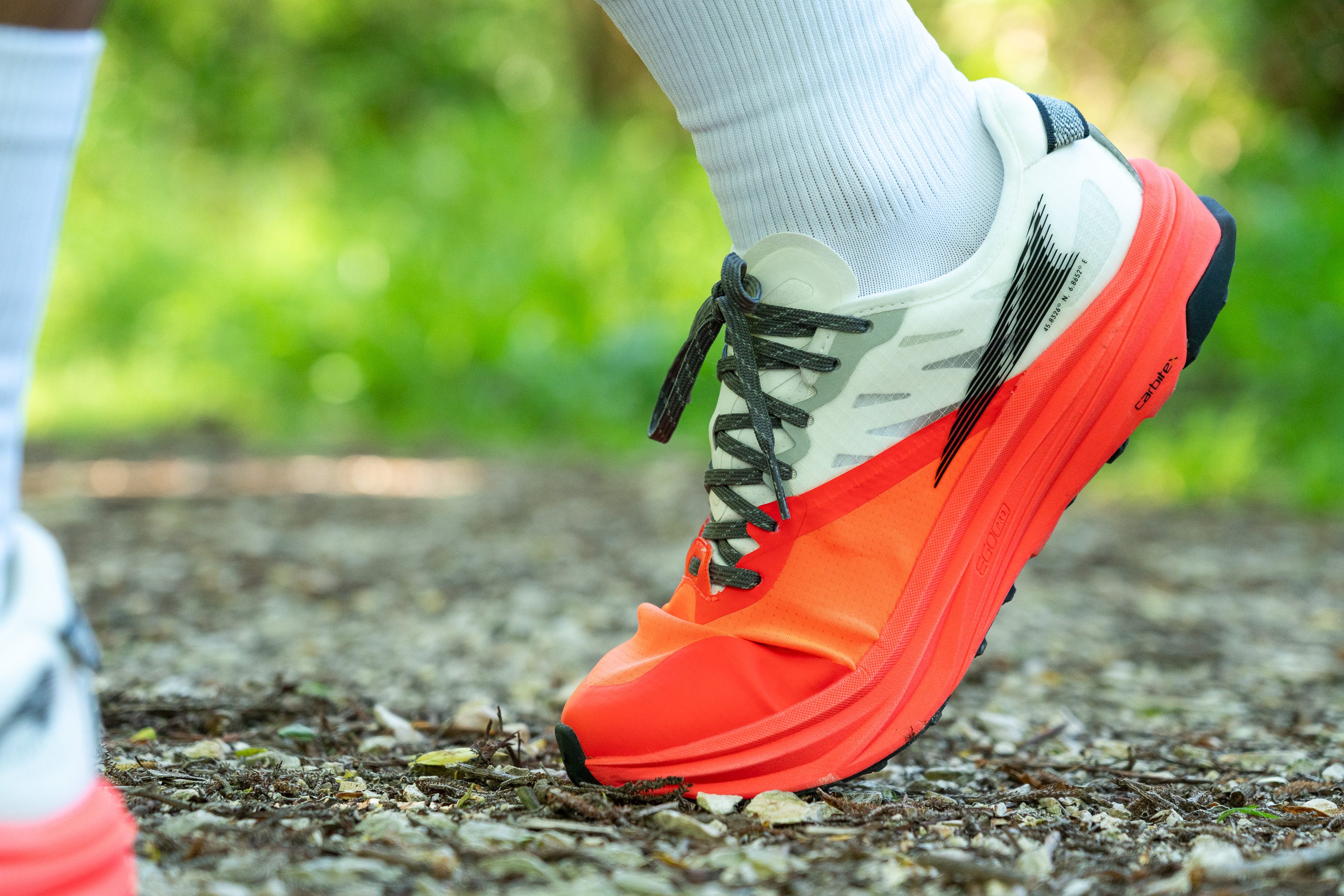
The answer lies in the collaboration between Altra and Carbitex. Altra requested a flexible carbon plate, and Carbitex responded by engineering a revolutionary plate named Monoflex. Despite being made of carbon fiber, it flexes and bends torsionally and longitudinally, much like a plastic plate.
| Mont Blanc Carbon | 2 |
| Average | 3.6 |
Heel counter stiffness
The heel counter is similar to those found in road racing shoes—it's very flexible and easily collapses under the force of our hand.
That's why we gave it a low rating, just slightly above the minimum, at 2/5.
| Mont Blanc Carbon | 2 |
| Average | 3 |
Midsole width - forefoot
The midsole of the Altra Mont Blanc Carbon at the forefoot measures 113.4 mm, aligning with many other trail shoes. This width strikes an ideal balance in our view—not overly bulky, yet wide enough to enhance stability underfoot, which we found to be a wise design choice during our test runs.
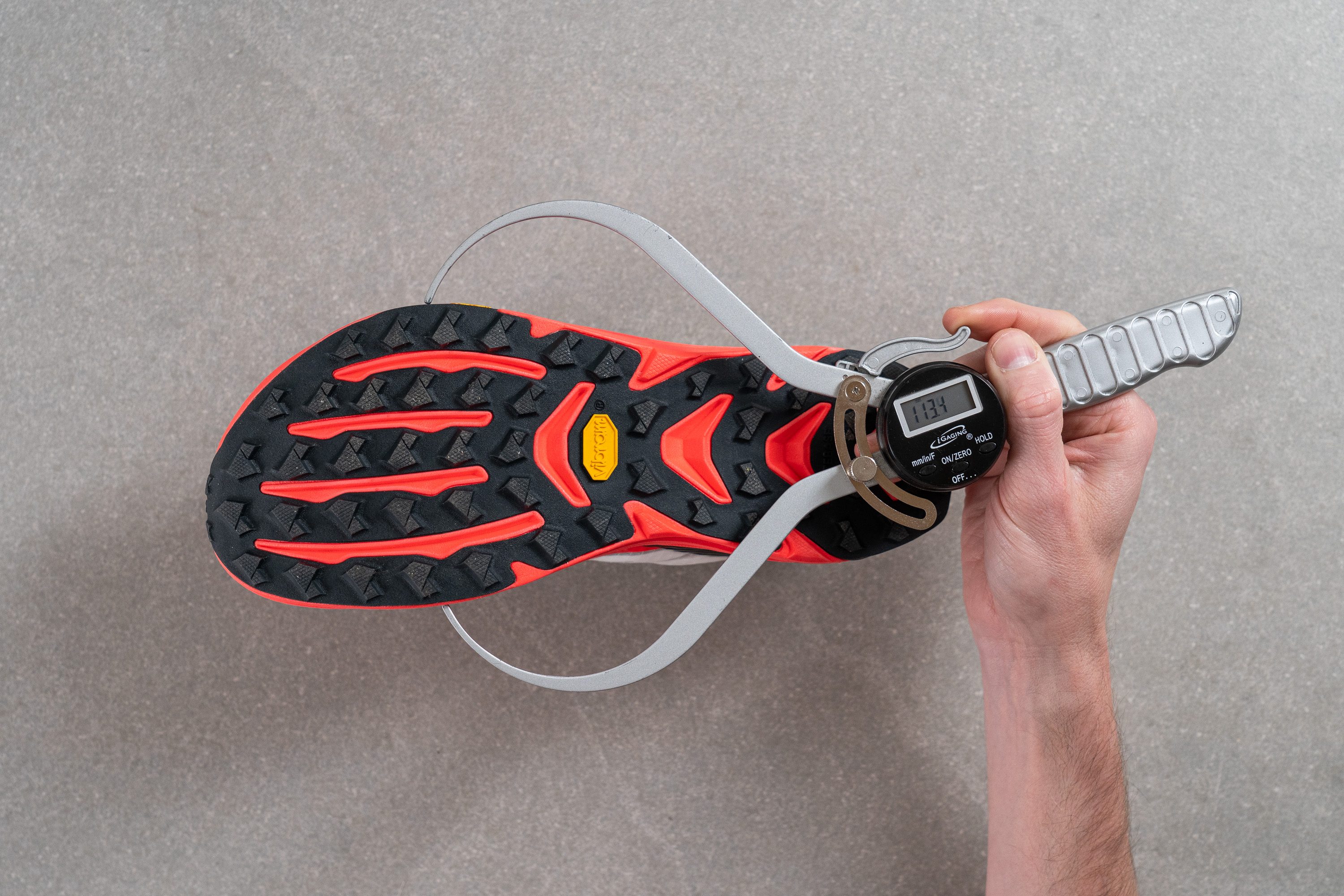
| Mont Blanc Carbon | 113.4 mm |
| Average | 112.8 mm |
Midsole width - heel
As we previously mentioned in this lab review, we do not recommend this shoe for heel strikers due to its very narrow heel area (84.3 mm). Conversely, this feature is advantageous for forefoot and midfoot strikers as it enhances agility and reduces weight, making it easier to take corners and execute fast turns.
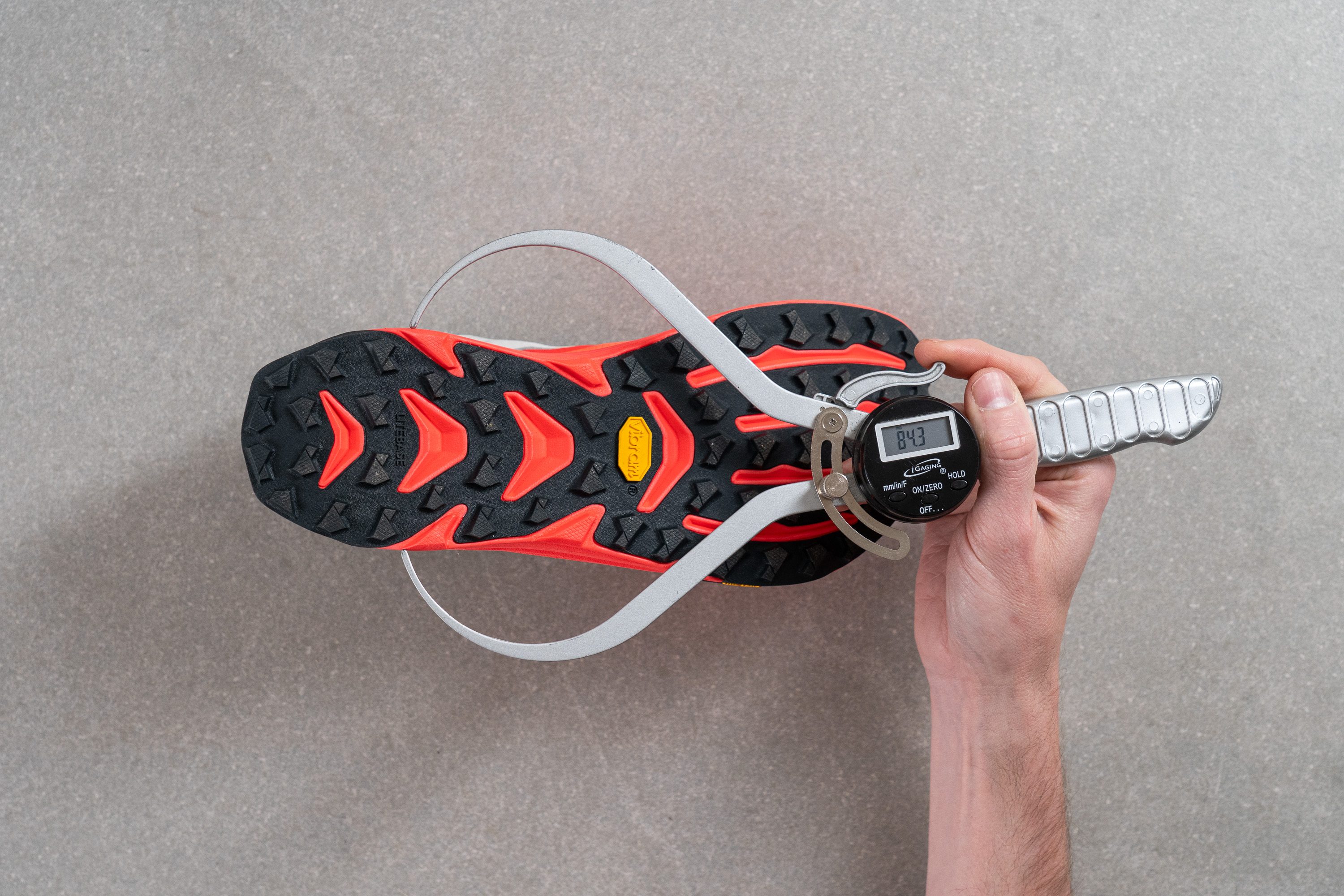
| Mont Blanc Carbon | 84.3 mm |
| Average | 89.9 mm |
Durability
Toebox durability
As a proper trail running shoe, the Mont Blanc Racer boasts TPU overlays on the toecap, enhancing its ruggedness. Besides, we conducted our Dremel test on the mesh—typically the upper's most delicate area.
Even though we tested the weakest part of the upper, we found the results to be good, earning a solid 3 out of 5. This score is more than sufficient for a trail racer, confirming that it successfully passes our rigorous testing standards.
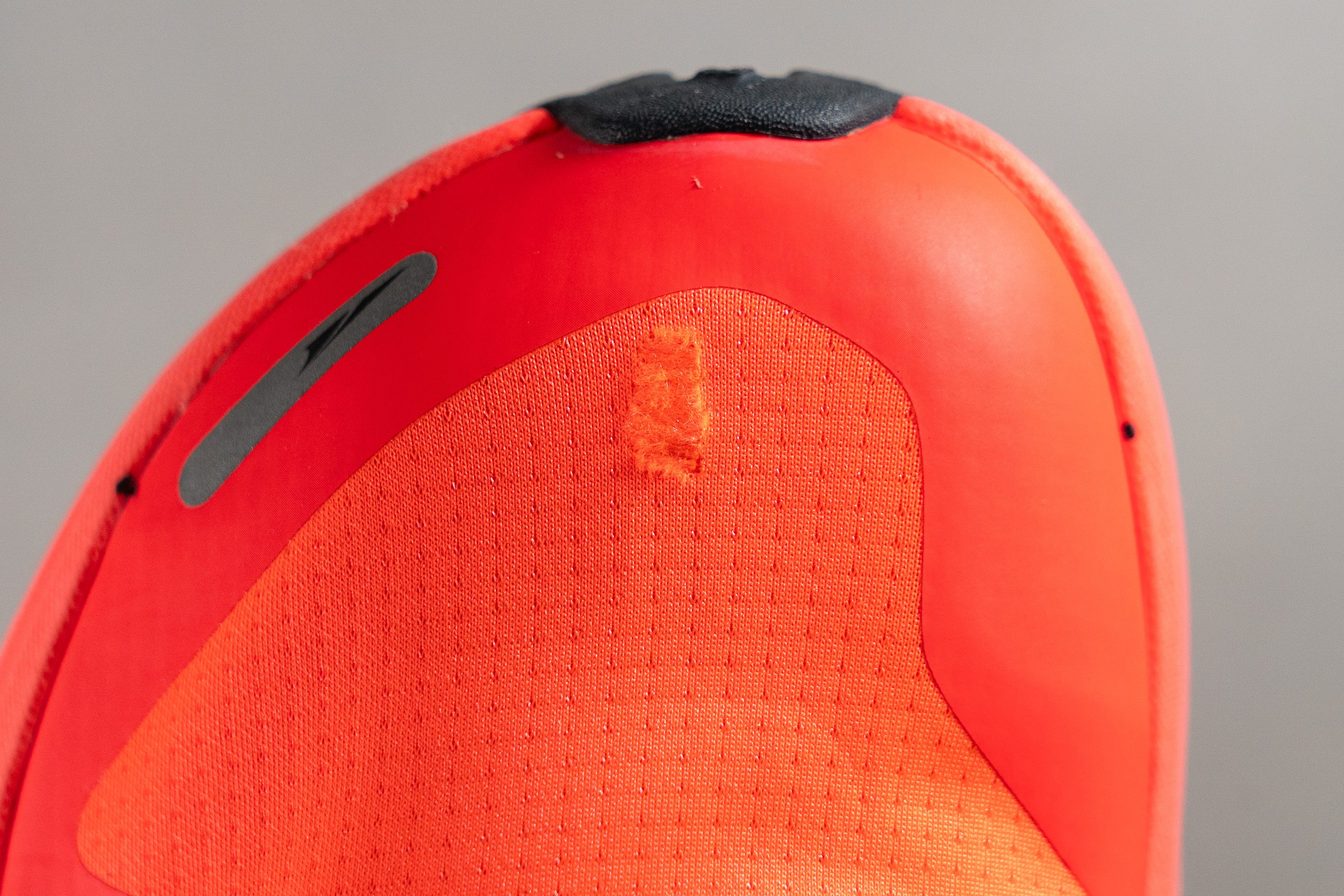
| Mont Blanc Carbon | 3 |
| Average | 3.1 |
Heel padding durability
The heel padding is very exposed and appeared fragile from the first look, prompting us to brace for a disappointing performance in this area.
As it turned out, the Dremel test obliterated the heel padding, handing the MBC a dismal 1 out of 5 in this assessment. This result raises significant concerns about heel slippage and the shoe's durability, especially for those who tend to wear down this area with their Achilles.
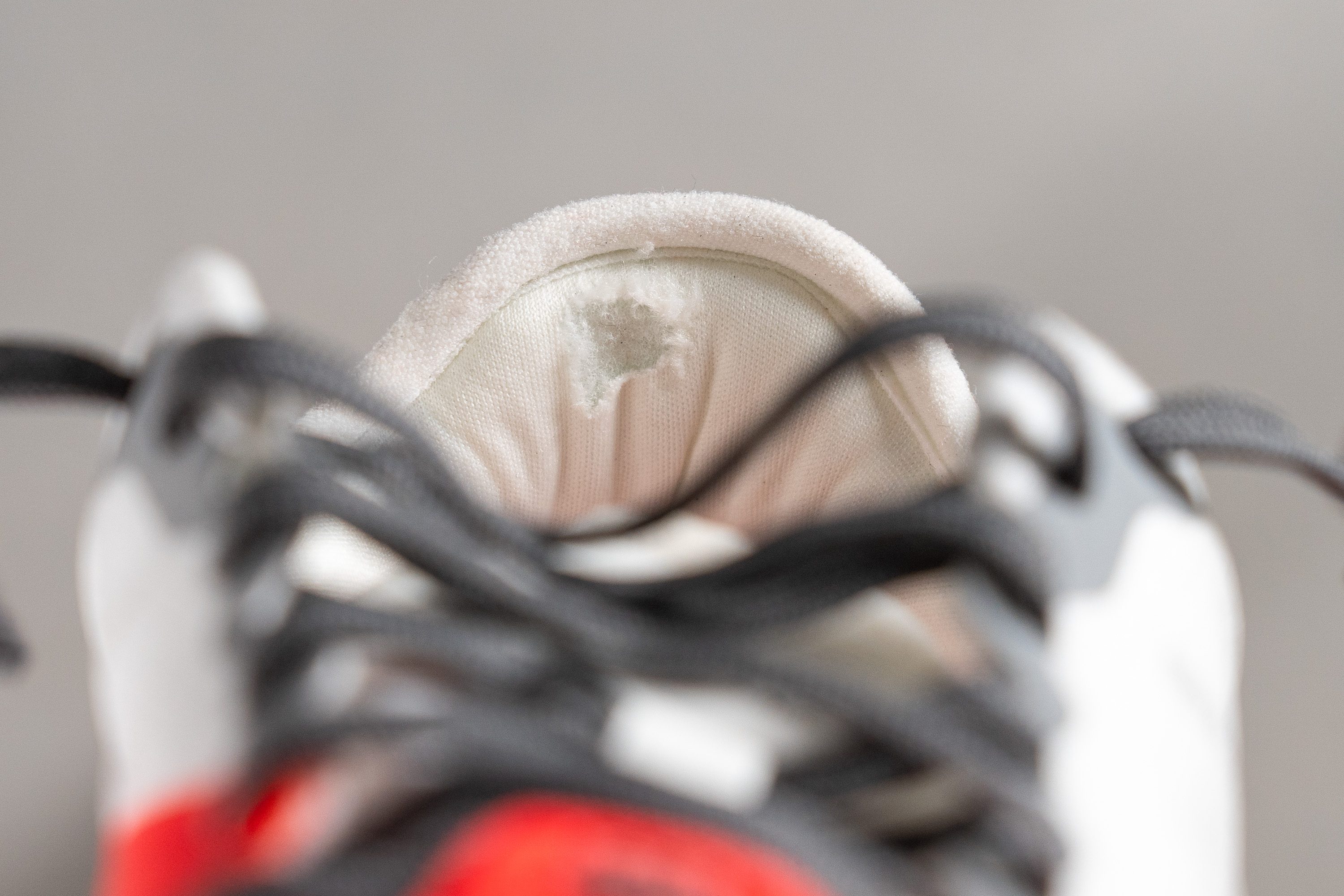
| Mont Blanc Carbon | 1 |
| Average | 3 |
Outsole hardness
After mixed results with the upper, we were keen to evaluate the outsole—one of the most critical components of trail running shoes. Our initial impression was promising, as we identified the Vibram logo and the Megagrip Litebase compound, which usually means excellent performance and lightness.
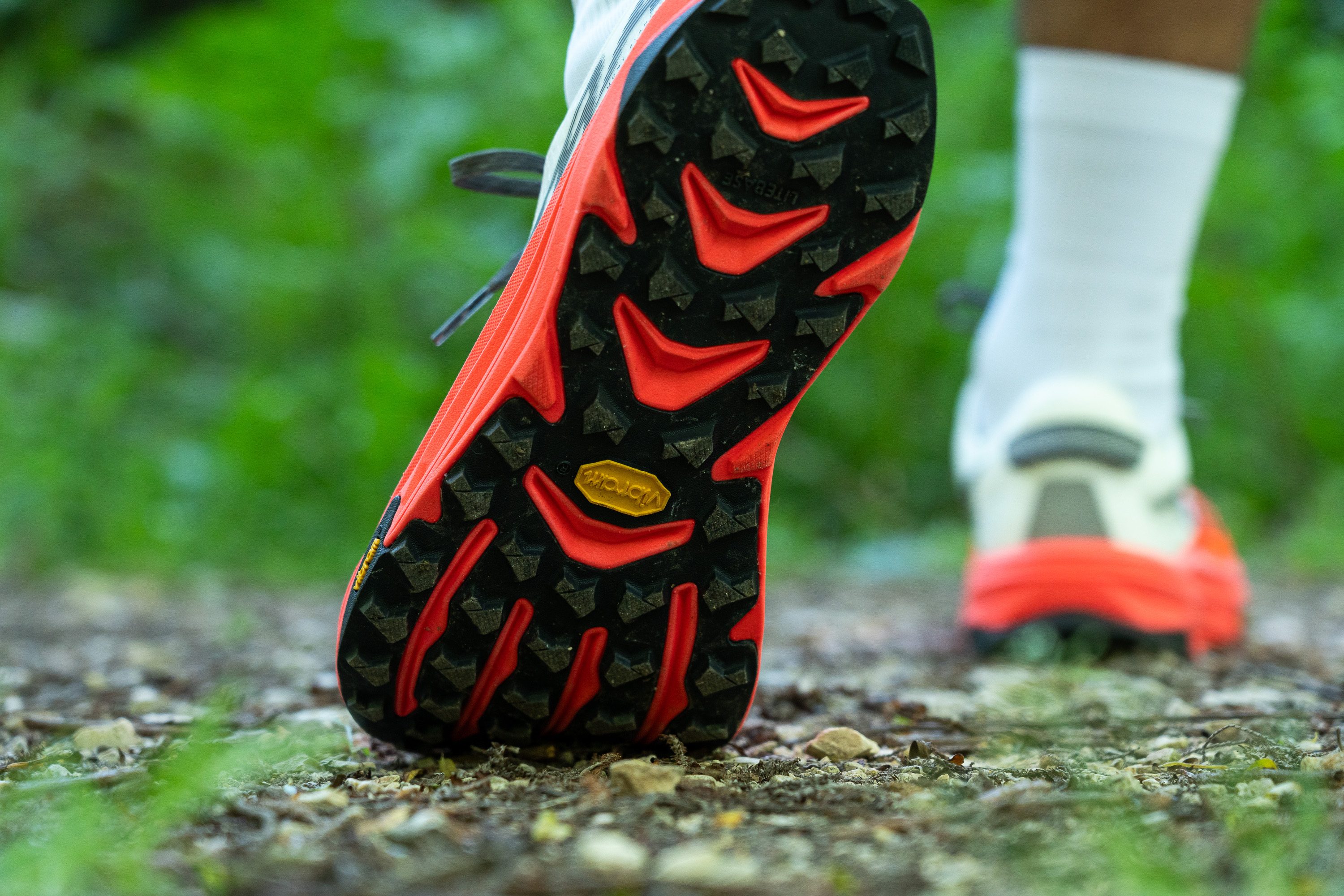
We then measured the hardness of this specific Vibram Megagrip formulation and discovered that at 88.3 HC, it closely matches that of other Vibram-equipped shoes, such as the Hoka Mafate Speed 4.
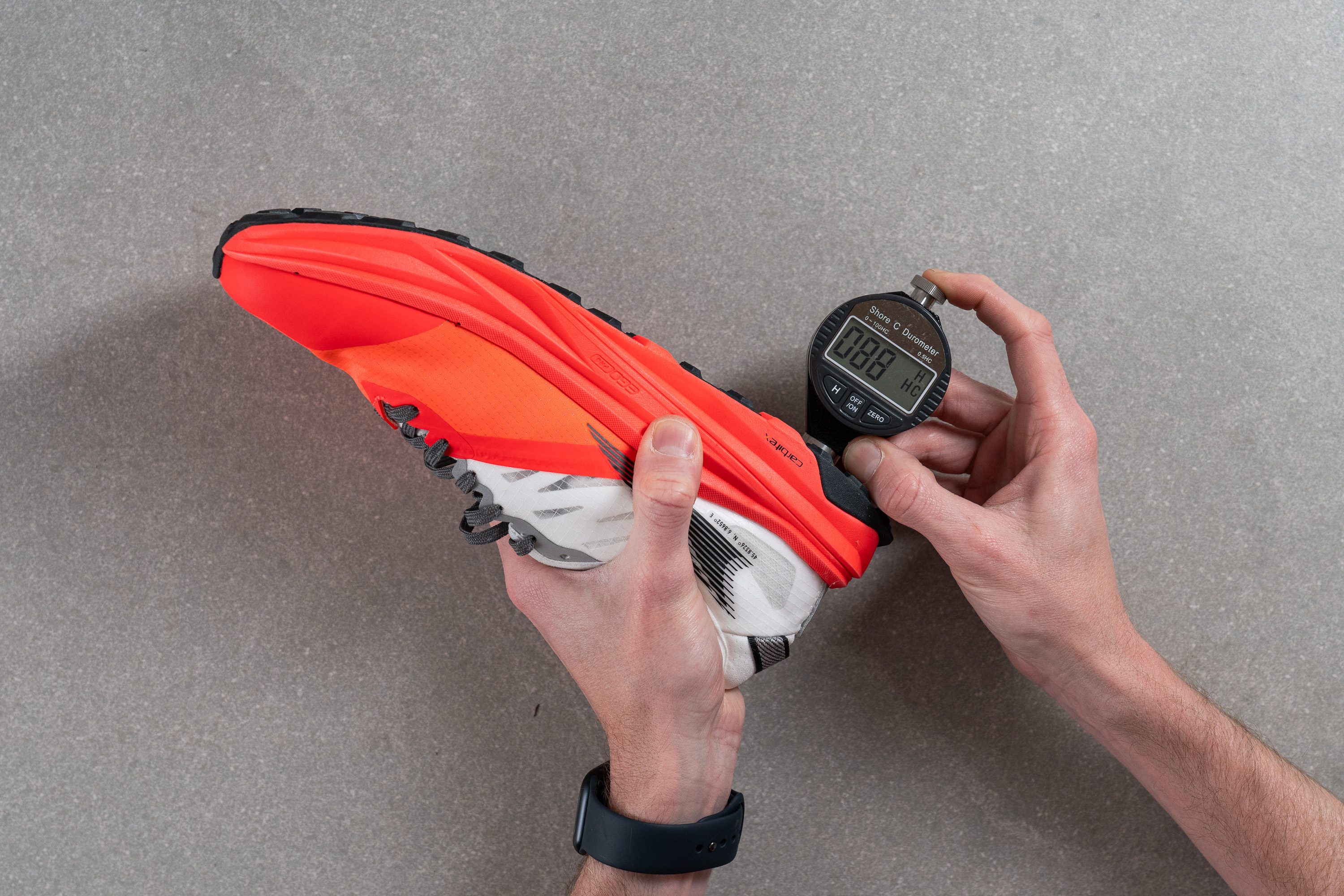
| Mont Blanc Carbon | 88.3 HC |
| Average | 85.8 HC |
Outsole durability
To verify the durability of the Vibram Megagrip rubber, we fired up the Dremel one last time.
The results exceeded our expectations. We found a minimal dent of just 0.6mm in the lug—this impressive performance assures that you'll likely get bored of the Mont Blanc Carbon long before the outsole shows any significant wear.
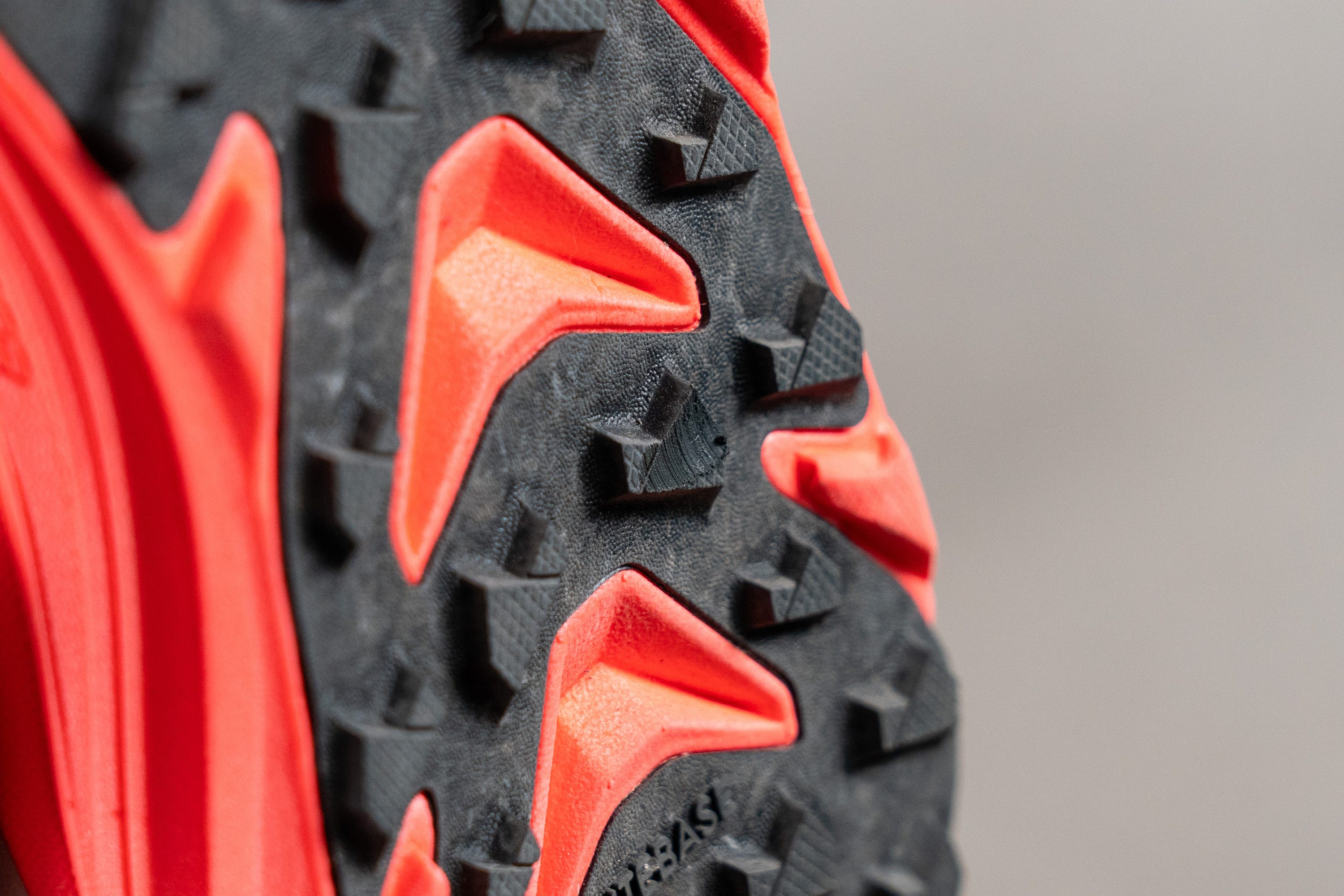
| Mont Blanc Carbon | 0.6 mm |
| Average | 0.9 mm |
Outsole thickness
Given the exceptional performance of the Vibram Megagrip rubber, we were not surprised to find a minimal outsole thickness of just 0.9mm.
There's no need for a thicker outsole when durability is already assured—increasing thickness would only add unnecessary weight. Additionally, the full-length carbon plate in the midsole acts as a rock plate and ensures ample protection for your feet.
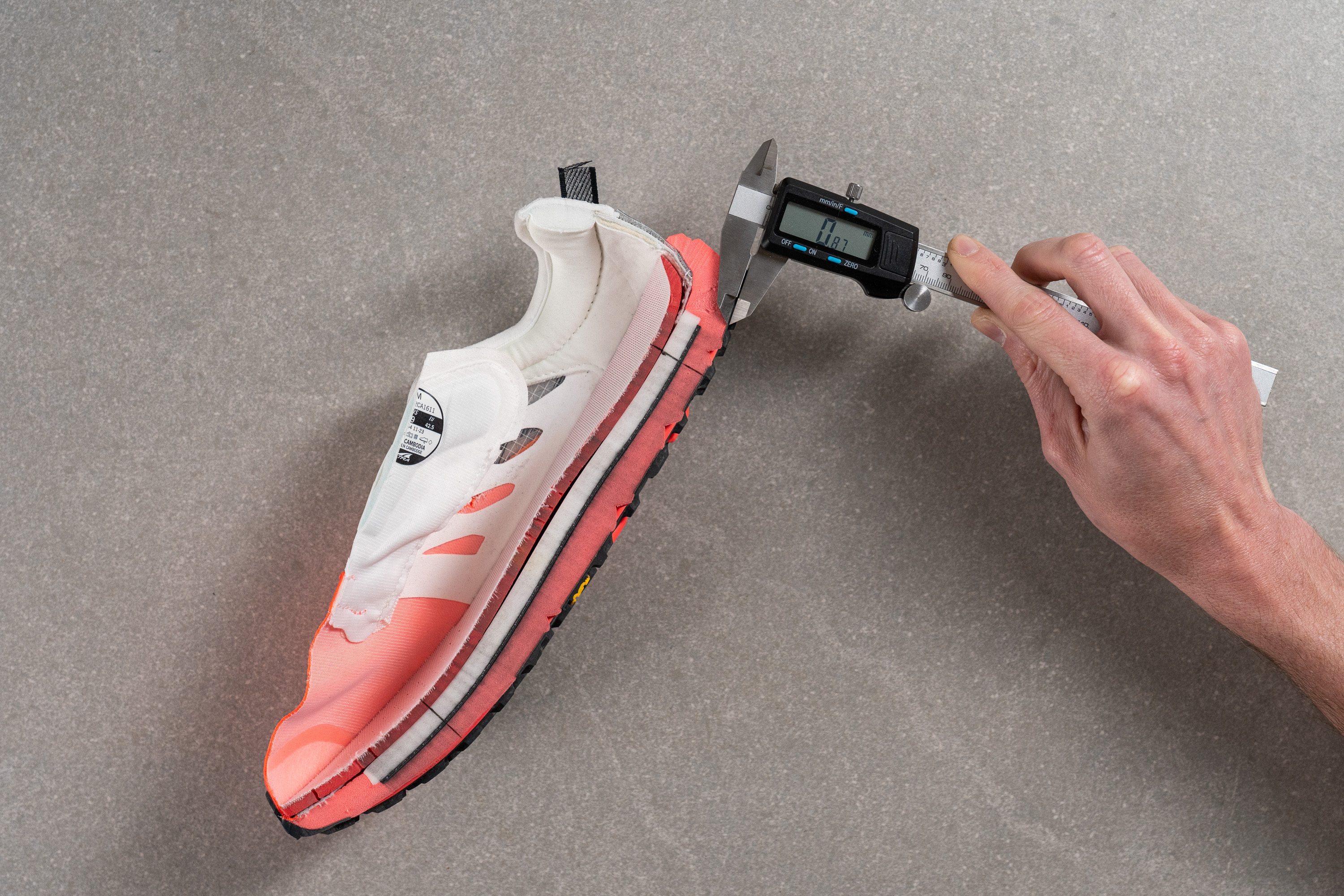
| Mont Blanc Carbon | 0.9 mm |
| Average | 2.2 mm |
Misc
Insole thickness
The insole of this shoe maintains a straightforward thickness at 4.5 mm—there’s not much that stands out about it. However, it’s worth noting that it’s somewhat thicker than the typical insoles found in racing shoes, which usually measure between 2 and 3 mm.
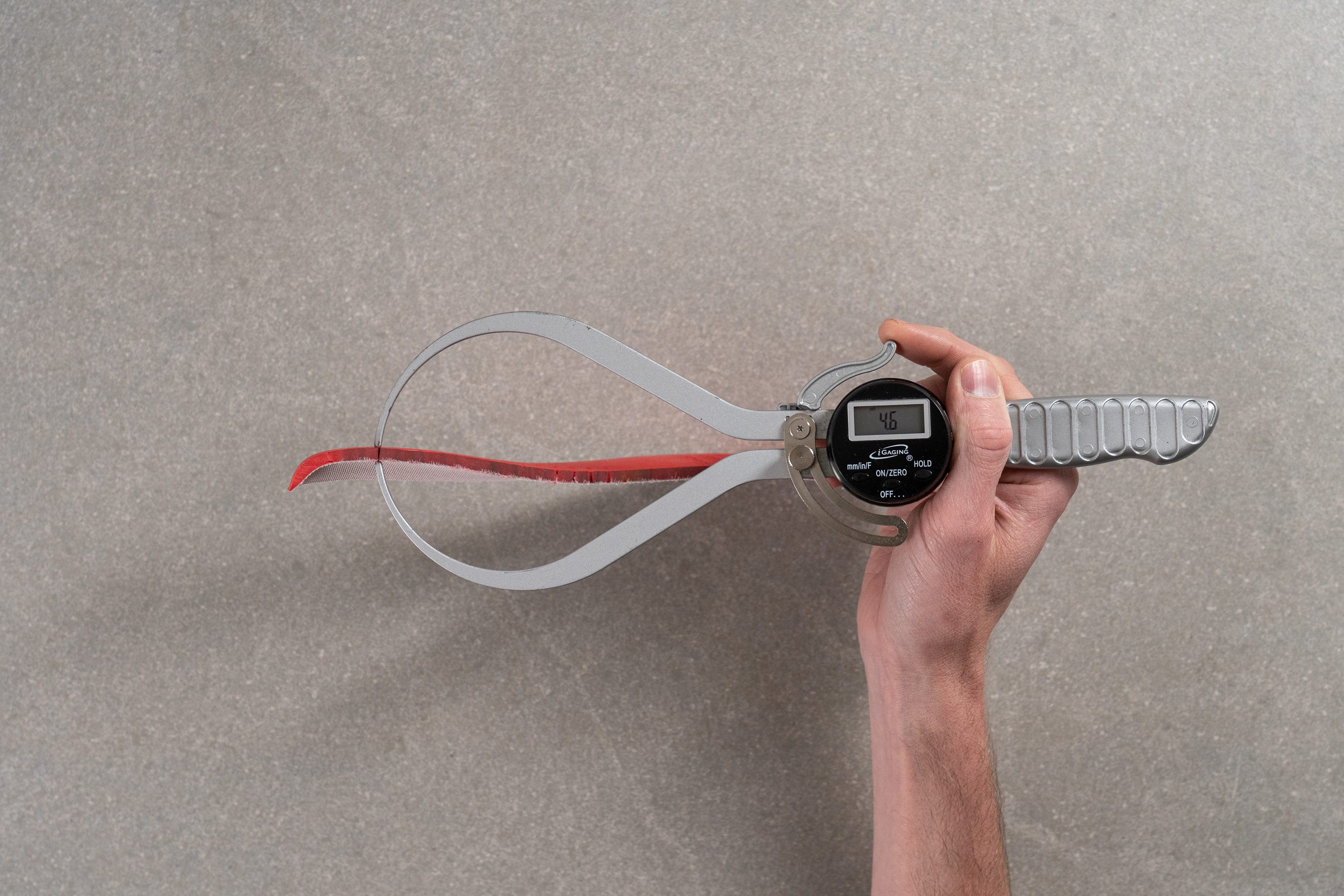
| Mont Blanc Carbon | 4.6 mm |
| Average | 4.7 mm |
Removable insole
The insole of the Altra Mont Blanc is removable—a feature not typically seen in racing shoes. However, there's a catch—since Altra uses a very specific last, finding suitable off-the-shelf footbeds might be challenging.
Additionally, we discovered that this is a great outsole, featuring perforations for enhanced ventilation in warm conditions. Therefore, we believe it's wise to retain the original footbed unless absolutely necessary to replace it.
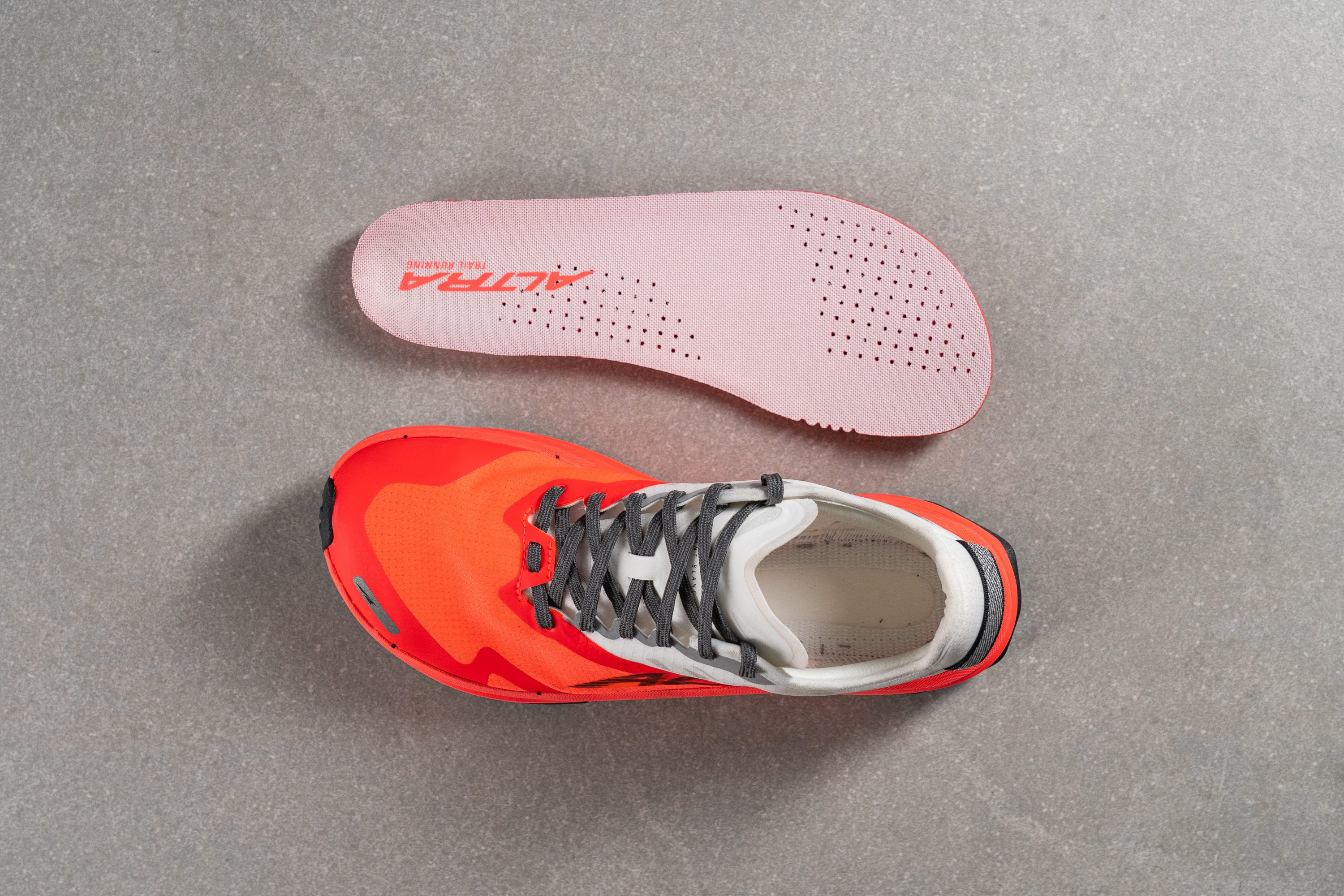
| Mont Blanc Carbon | Yes |
Midsole softness in cold (%)
We discovered that the Mont Blanc Carbon becomes 32.5% firmer after spending 20 minutes next to our ice creams in the freezer.
It's truly disappointing to see such subpar performance in this test, especially given the high cost of the shoe. But since the main foam contains EVA as its primary component, there’s an unavoidable decline in softness under freezing conditions.

| Mont Blanc Carbon | 33% |
| Average | 26% |
Reflective elements
We absolutely love reflective elements on all shoes, and we consider them essential for trail shoes—especially those likely to be used in ultra marathons, where racing at night is common.
| Mont Blanc Carbon | Yes |
Tongue padding
The tongue of the MBC was a delightful surprise from the moment we first tried it on. At a glance, it appears remarkably thin, yet this is due to the padding being strategically positioned over the instep rather than throughout the entire tongue, as is common in most running shoes.

As a result, Altra has successfully added 5.3 mm of thickness to the tongue of the Mont Blanc Carbon without noticeably increasing its weight. And it's a positive trade-off.
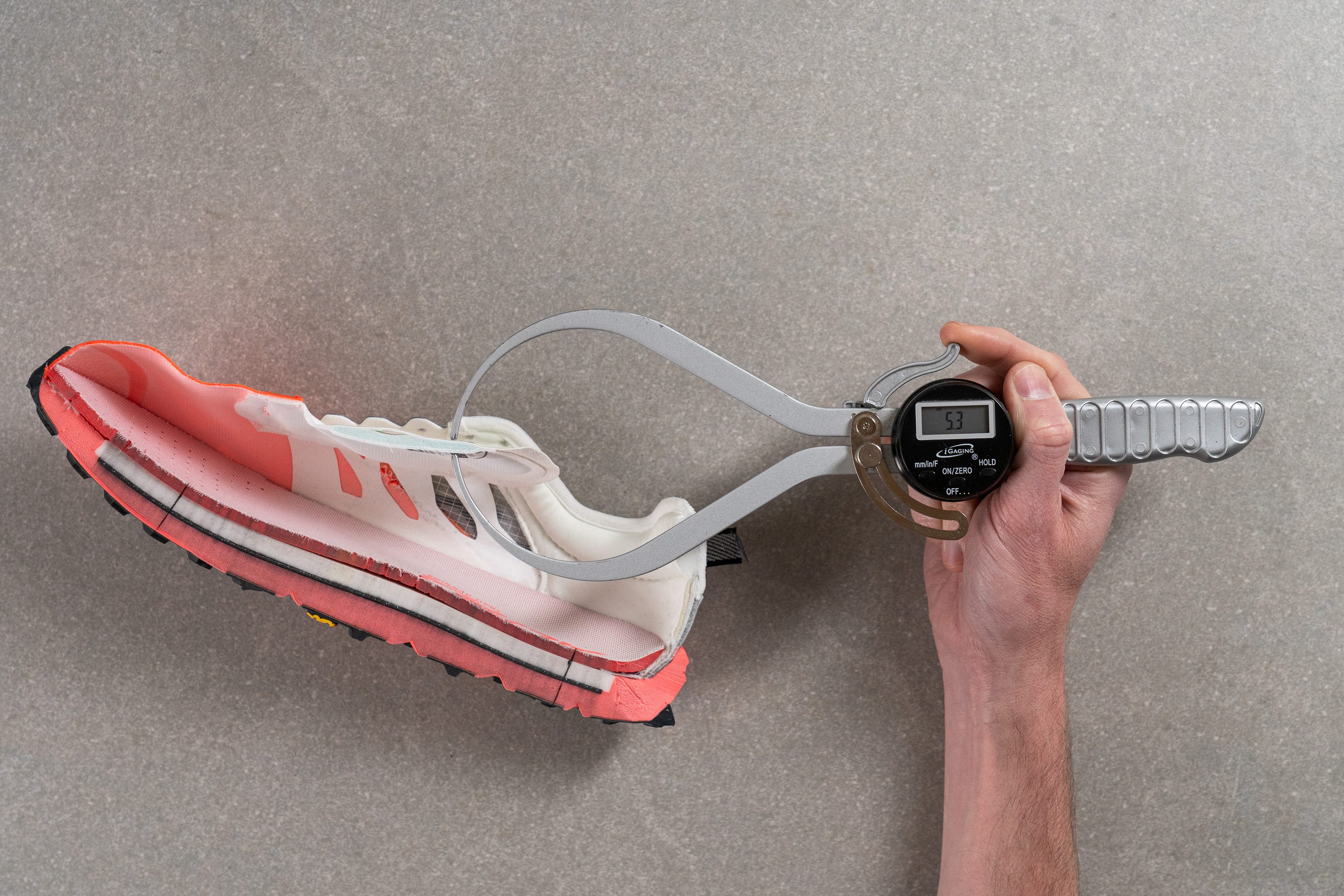
| Mont Blanc Carbon | 5.3 mm |
| Average | 6.4 mm |
Tongue: gusset type
We know that when someone invest $260 in a trail running shoe, it's normal to expect perfection down to the smallest detail, and happily, the Mont Blanc Carbon meets these high expectations.
We were happy to find a fully gusseted tongue, which not only prevents unwanted movement while running at fast paces, but also keeps debris away from the toebox.
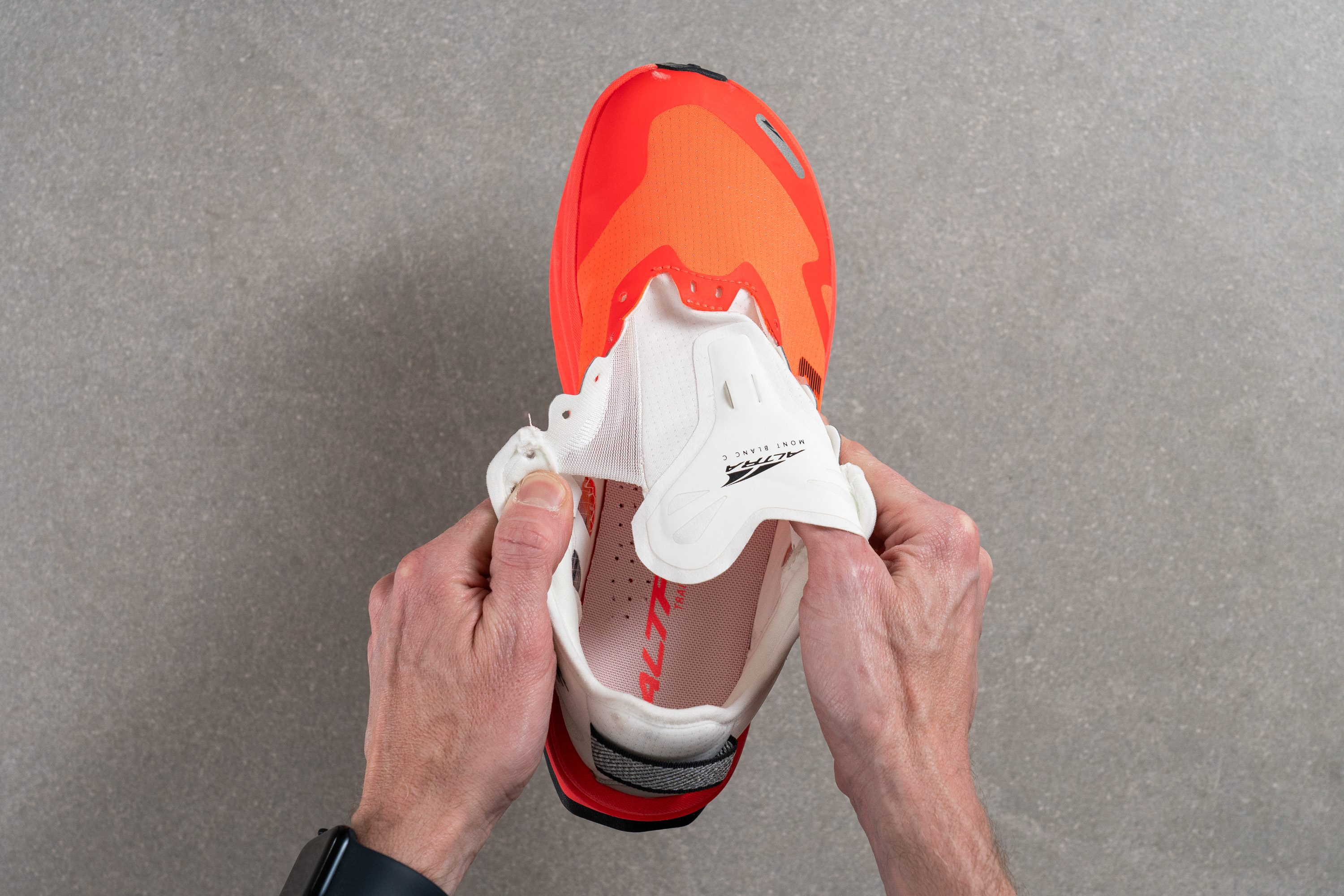
| Mont Blanc Carbon | Both sides (full) |
Heel tab
The heel includes a reflective, horizontal finger-loop heel tab that not only adds a stylish touch, but we also found that significantly simplifies slipping your feet into the shoe.

| Mont Blanc Carbon | Finger loop |

